BattleTech - A Time of War by Doresh
A Universe at War
Original SA post BattleTech - A Time of War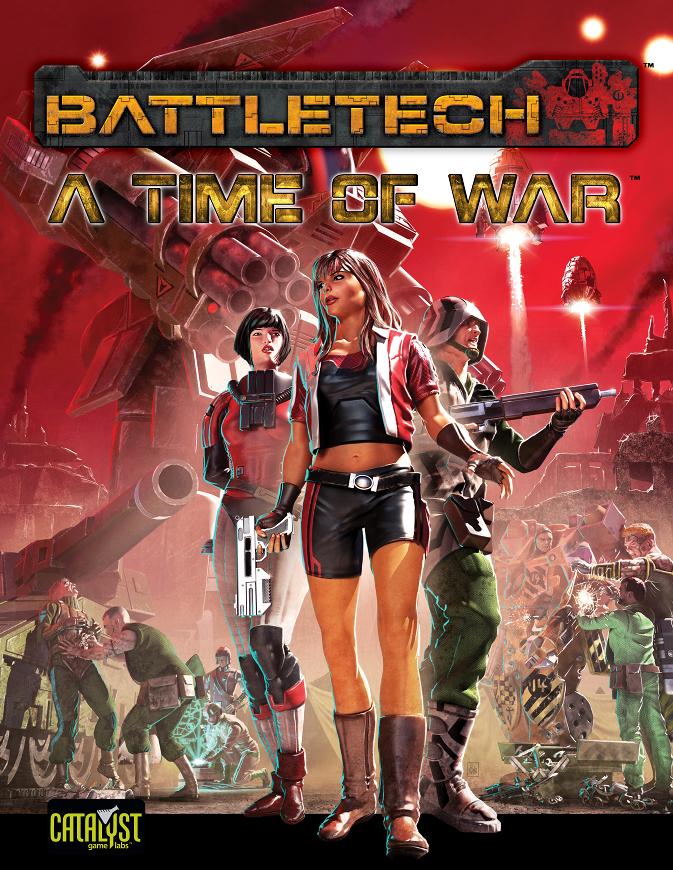
BattleTech AToW is the fourth roleplaying game set in the world of BattleTech, the grandaddy of stompy mech wargaming. Unlike the previous editions, it is not called MechWarrior in what I assume is an effort to tie the whole thing closer to the main game line. Action resolution is exactly like in normal BattleTech (with a slight modification), and it offers some nuggets for the wargamers, namely pilot abilities (which have ben ported over to the streamlined spin-off game Alpha Strike) and rules for skirmish-scale fights which I think are a spiritual successor of BattleTroops, a short-lived infantry skirmish spin-off.
So, before we begin with the game proper, let's take a quick overview of the setting, in which I'll totally not forget important stuff because I my first exposure to BattleTech was MechWarrior 4 (plus a demo of MechCommander, but I barely remember anything aside from the opening) and it took me a while to find out what this Clan stuff was all about.
Anyhow, here's the world of BattleTech in a nutshell:
A Universe at War (Aka A Game of Space Thrones)
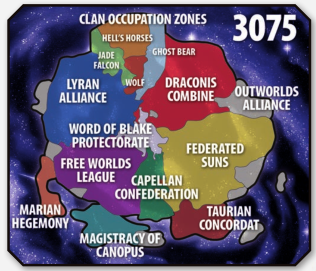
The default time period of the game.
The main focus of BattleTech is the Inner Sphere, aka most of known space that has been colonized. The huge distances between the various world has led to a resurgence of feudalism, with planetary governors having more or less freedom to rule their world while swearing their loyalty to one of the Great Houses.
The iconic BattleMechs (or just 'Mechs) of the setting entered the picture in the time between the 24th and 28th century known as the Age of War, the first big war that engulfed the entire Inner Sphere. It was during this time that the Great Houses cemented their positions as interstellar players, the so-called Ares Convention was brought to life in order to avoid everyone nuking the crap out of each other (with the side-effect of war becoming a sort of gentlemen's sport, with normal citizens hanging up a different flag depending on whose 'Mechs are currently stomping around), and BattleMechs entered the stage in the form of the amazing Mackie:
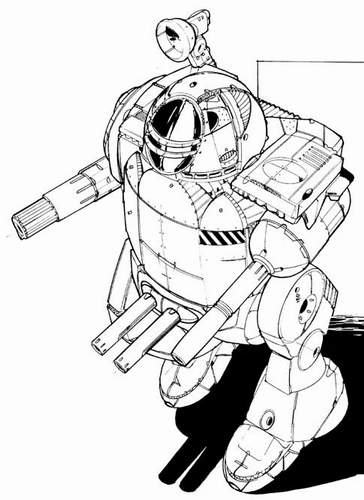
Clearly not compensating for anything.
The Age of War ended when the mighty House Cameron (ruler of the Sol system and the surrounding systems) united the other Houses to form the Star League, heralding a Golden Age of lasting peace and amazing technological advances. Unless you live in the Periphery (aka the colonized space surrounding the Inner Sphere proper) that is. Then you got kinda sorta integrated into the Star League via conquest, leading to the people of this region to have a somewhat less rose-tinted view of this era.
The Star League lasted almost two centuries until Stefan Amaris, a Periphery lord and close advisor of House Cameron betrayed said House, annihilating it and taking over the Star League. What followed was a costly civil war between Amaris and his goons and the loyalists under general Aleksandr Kerensky.
When Amaris reign was finally put to an end, the other House more or less immediately started fighting among each other over who would succeed House Cameron. Not very amused by this, Kerensky essentially went "Screw this, I'm out of here" and left with a good chunk of the SLDF (Star League Defense Force) to parts unkown, never to be seen again.
The following three centuries had the Great Houses engage in a grand total of four Succession Wars, with the first two escalating so dramatically that they ditched the Ares Convention entirely and nuked each other into a dark age so hard that they eventually lost the capabilities to build FTL drives.
With their mighty WarShip fleets blown up to the last ship and now left with irreplacable JumpShips, the Houses had no other choice but to revert to a more Ares-Convetion-appropriate kind of warfare (aka dropping a bunch of 'Mechs and other vehicles on a planet to take over the local spaceports).
Terra, the old center of the Star League and House Cameron, was controlled by ComStar during all this time. This organization not only had a monopoly on the HyperPulse Generator (HPG) network (the only kind of FTL communication around), but also horded and maintained lots of Lostech from the Star League era, including the only remaining WarShip fleet, mothballed in a secret location. Suffice to say, nobody wanted to get on their bad side, making Terra the planet least touched by the wars and dark age going on.
During the Succession Wars, StarCom developed some cult-like qualities aking to 40k Tech-Priests, but they eventually mellowed out and had the nutjobs among their ranks hang out in their own sub-faction known as the Word of Blake, named after their founder.
In 3048, the Inner Sphere has finally started to recover some of the technology from the old Star League, when the Clans suddenly showed up.
As it turned out, Kerensky and his fleet colonized a group of systems far away form the Inner Sphere, where they have prepared all this time to eventually return to the Inner Sphere and rebuild the Star League. To do this, they formed a caste-based society with the Glorious Genetically-Enhanced Warrior Master Race on top and the Dirty Normie Peasants at the bottom, big on honour and using a weird slang that reminds me of A Clockwork Orange (because Kerensky was Russian, you see). Think eugenics Klingons.
The Clan Invasion started off pretty badly for the Inner Sphere. Not only did they have to deal with an invasion fleet out of nowhere, but the Clans not only retained Star League technology, but actually improved on it, fielding 'Mechs that were noticably overgunned compared to their Inner Sphere counterparts of the same tonnage.
Eventually, the invasion came to a halt when the forces of the Inner Sphere started to exploit the Clanners' honour codes, and the Clans themselves started arguing among each other over whether their plan to conquer the Inner Sphere and rebuild the Star League by force really works with their old SLDF obligation to protect the Inner Sphere.
Though in a way, they got what they wanted, because the Great Houses banded together to fomr the second Star League. Though the Houses being what they are, the League didn't last particularly long...
... which leads us to 3067, the start of the default time period of AToW. You see, one of the teaching of the World of Blake was that a second Stear League with the WoB as its member would herald a new Golden Age for mankind. They didn't really take the quick disbanding of the League very well - and by that I mean they went totally ballistic, started a Jihad during which they took over Terra and used lots of fancy super weapons, created entire armies of rad killer cyborgs, and allied themselves with Hindu death cult assassins (no kidding) that made even radder killer cyborgs with multiple limbs and stuff. They also employed some dirty tricks like in the halcyon days of the early Succession Wars, bombing cities and destroying more or less irreplacable infrastructure. Fun times.
The Word of Blake eventually met their doom when they found out that starting to use nukes again does in fact result in everyone else banding together to nuke them back in return. The followng decades went relatively peaceful (aside from some shenanigans in the Clan homeworlds like a scientist caste revolt and the Clans who stayed feeling that the Clans who invaded the Inner Sphere have lost their way or something).
Things went more interesting in the 32th century, when the sudden blackout of the HPG network caused another Dark Age, an era of turmoil in which the Republic of the Sphere (a sort of spiritual successor of the Star League) tries to restore order.
Even this era is starting to come to an end, for it seems that the Clans may unite and become one...
Fun facts about the BattleTech setting
The only aliens in the setting are animals, and maybe a few kinds of plants*. This is because the writers felt aliens would be either too primitive to matter, too advanced and/or aliens to interact with, or too similar to humans (they're probably not big fans of aliens that are just humans with weird skin color and head ridges). There are also no ancient artifacts of some kind of precursor alien civilization; the only ruins to be found are from old Star League expeditions. All in all, each and every conflict in the setting is derived from humans doing what humans do best: being dicks to each other.
This is not to say that the humans don't find it weird that they're the only kind of sentient life around. In fact they freaked the hell out during the early days of the Clan Invasion because they thought they were attacked by aliens.
*) Okay, there are some tribal bird people, but many fans are eager to deny their existance despite the fact they only appear in one early novel and live so far away from the Inner Sphere as to not actually matter at all. There are also some tool-using primates around, but that doesn't sound particularly fance. Oh, and there's a species of giant monster whales with Aquaman powers who have apparently declared a war on the humans living on their ocean planet, which sounds pretty nifty, to be honest.
Likewise, there is no kind of supernatural stuff to be found. No psychics, no Force, and no Newtypes - unless you count the rare Phantom 'Mech incidents, in which a 'Mech managed to get hit with at least one Alpha Strike at point-blank range without getting hit a single time. Some kind of actual supernatural ability, a super-secret form of ECM, or maybe just hack writing? The world may never know.
Probably well-known, but the creators of BattleTech ran into a couple lega troubles early on. The original name of the game was BattleDroids, which obviously didn't flew well with George Lucas' lawyers, and they licenses many mecha designs from old shows like Macross, Dougram and Crusher Joe, which led to some license shenanigans because they didn't have the license for the actual shows (unlike companies like Harmony Gold) and who knows if the people they got the licenses from actually had the right to sell them and I don't even want to go into much detail because this is very confusing and every BattleTech grog seems to have their own version of what actually happend and this is all a very big
 so I'll stop now.
so I'll stop now.
The end result was that these licensed 'Mech became Unseen, still existing in the setting but without visual representations of any kind. Years later, most if not all of them would resurface as the Reseen, with newly commissioned designs that often beared little resemblance to the original, but where nifty in their own right.
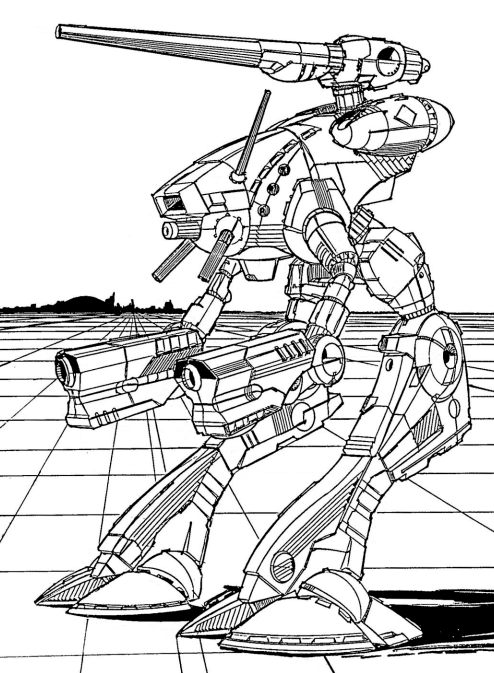
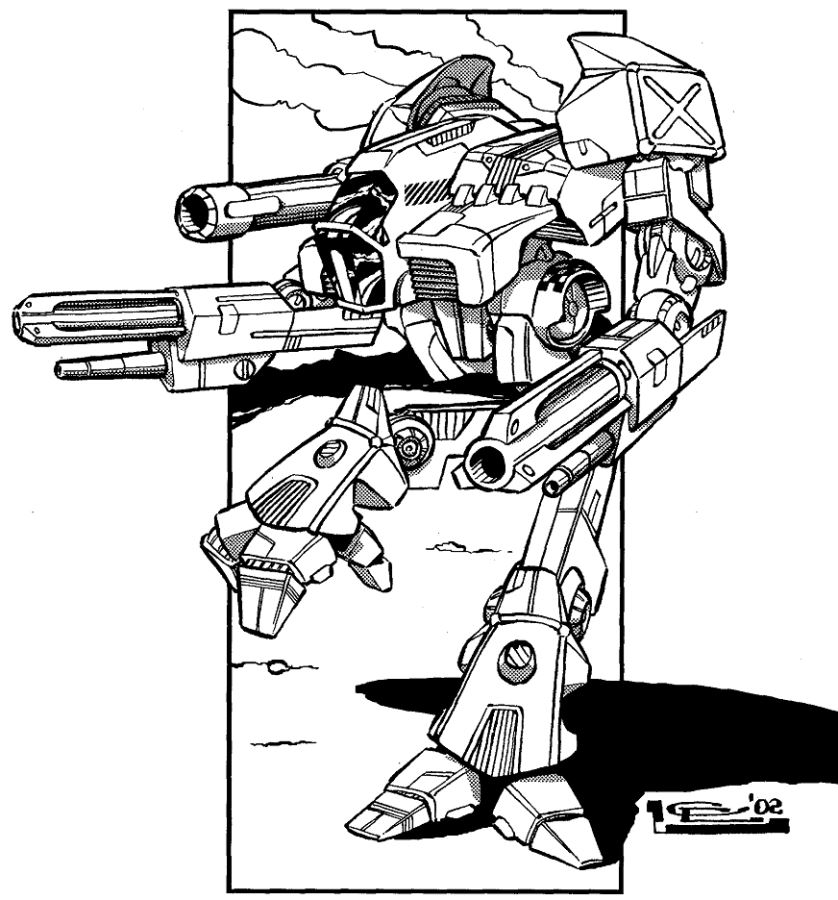
The Marauder before and after the great purge.
The Dark Age era was actually created by WizKids for their MechWarrior: Dark Age spinoff game, with the Jihad mentioned in the fluff. Catalyst Game Labs where contractually obligated to include both events in their evolving metaplot, with opinions divided on how well this worked out.
Next Time: Lets start character creation by taking a look at the factions to pick from.
Rules Overview
Original SA post BattleTech - A Time of War
Rules Overview
AToW uses the classic BattleTech action resolution of "roll 2d6 and try to get equal or above the Target Number". Wheres BattleTech's Target Number is typically one of the pilot's various skills (aka the lower the skill, the better) with situational modifiers slapped onto, AtoW takes the more traditional roleplaying approach of applying skills and other modifiers to the roll (aka higher skills are better).
Both approaches are equivalent and in fact the same formular with the numbers switched around. Aside from AtoW's version being the more standard one, the book also notes how this allows the characters to have far higher skill ratings than BattleTech allows (since you can't get negative skills there). Not that this will come up often seeing how character advancement is slow and most starting PCs are lucky to be even as good as the default BattleTech pilot, but I'm getting ahead of myself.
The Stats - or in this case Attribtues - of the game are Strength (STR), Body (BOD), Reflexes (RFL), Dexterity (DEX), Intelligence (INT), Willpower (WIL), Charisma (CHA) and Edge (EDG). All of them are self-explanatory aside from EDG, which is actually your pool of not-Fate points.
Attribtues range from 1 to 10 (with 4 being the average), and they work like in d20 systems in that they are mostly there to provide modifiers to skill rolls, though they don't provide as much of a bonus (an Attribute of 10 gives you a +2, for example).
For you daily dose of Merits & Flaws, the game offers Traits. They are somewhat odd in that each has a level (which can be negative or positive depending on the Trait), but each Trait will only have certain thresholds that actually do anything. This is because levels cost the same for every Trait, but the Traits themselves are more or less powerful.
Skills come with your typical stuff like subskills and specializations. Each Skill also comes with a Complexity Code which denotes the general difficulty to perform and learn the Skill, and it determines the Skill's default Target Number (which can range from 7 to 9).
Yes, different Skills can have different Target Numbers. I guess its because some are more useful, but they all cost the same to learn and raise?
Some skills are known as Tiered Skills which will upgrade themselves into a more advanced version once they hit a Threshold. This does bump up the Target Number, but lets you add modifiers from two Attributes to checks. These Tiered Skills let you differentiate between a guy who knows how to punch and a guy who knows Kung Fu, or your average computer user and your l33t haxx0r by walling off more advanced and sophisticated skill applications behind the tier wall.
Though they aren't brought up properly until the combat chapter way later, the two derived stats of AtoW are your Damage and Fatigue boxes, equal to twice your BOD and WIL, respectively. The latter choice is particularly interesting as it means staying concious from non-lethal sources of harm is a matter of having balls of steel instead of high endurance.
On the other hand, this makes BOD and WIL very clear candidates for the best stats. The game's a bit lethal to say the least, and every point in either stat is very handy.
The Fires of Hell
I'll mention this briefly. This is a little ongoing short story strewn throughout the book, with each section having more or less somewhat to do with the contents of the current chapter. It deals with a motley crew of Lyran soldiers preparing to investigate an outpost of the Word of Blake. Notable not-PCs of this not-party include Busby, the tough Russian guy, Ethan Naoko, a Japanese veteran who has seen it all, Grace, a pacifistic doctor who will totally not be forced to kill a guy later on, and Franz, the awkward 'Mech otaku who was too incompetent to finish MechWarrior academy and will totally not end up in the cockpit of a 'Mech anyways.
If that cast doesn't sound more interesting than the guys from the actual BattleTech cartoon, I don't know what's going on anymore.
Character Creation Stage 0: Affiliations
And here's where the fun begin. You see, character creation in AToW is essentially point-buy, always using the same kind of XP you'll gain later on. Since characters in this game are very frontloaded, you start of with 5,000 XP. An Attribute or Trait level costs 100 XP, while Skills can be learned at 20 XP and go more expensive with each increase.
AToW also has this odd thing where you don't have a general pool of unspend XP and must assign each point of XP to some Attribute, Trait or Skill, meaning almost everything on the character sheet has its own pool of XP.
The standard way of creating a character involves going through different Modules, each representing a stage in your character's life. These are mostly just packages of pre-spent XP, but the higher education Modules actually give you a few extra XP.
Once you've gone through this rather lenghty step and have added up a lot of XP for Skills and whatnot, you keep adding XP from your big starting pool to your Attributes, Traits and Skills till they hit their next full level (essentially "rounding up"), and then you are free to spend the remaining XP however you wish.
I think AToW might just have one of the few character creation rules where your Attributes are the last thing to be determined. Sure, you get a few XP to some Attributes, and several Modules require a minimum in a certain Attribute you have to meet by the end, but Attributes are pretty much the last step here.
A faster and more focused approach just has you spend those 5,000 XP however you wish. You don't get extra points from higher education, but it's easier to min-max.
Lastly, you can just pick one of the example characters and tinker with it.
Stage 0 of character creation is where you pick your character's Affiliation, aka where he comes from. this is a perfect excuse to talk about the factions of BattleTech, since this is what the Affiliations are.
Each Inner Sphere Affiliation is a hodgepodge of at least a handful of cultures and their languages, but one of them - namely the one of the ruling House - is the primary one.
(Many of the bigger factions also have you pick a Sub-Affiliation for the exact region you're from. You have to look at their bonuses to infer anything from these regions, as the book doesn't really cover them.)
Capellan Confederation (House Liao)
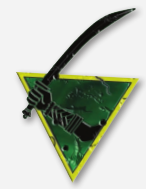
Basically the grandson of Soviet Russia and China. Interestingly for a sci-fi setting from the 80s, the Chinese influence are by far the most dominant, with the only big trace of the Russian heritage being the fact that their Secret Service is called Maskirovka.
Aside from being a bit oppressive, Capellans are big into ancient Chinese culture and are ruled by a Chancellor whose first name is Sun-Tzu. Of course.
They are also the only major Inner Sphere faction where you actually have to buy full citizenship rights. Some people are just more equal than others.
Draconis Combine (House Kurita)
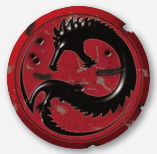
Space Japan (except not everyone is Japanese). Since the setting is again from the 80s, the Draconisians/Combiners/whatever are of course space samurai, big into honour, seppuku and more honour. They also really, really hate outsiders.
Federated Suns (House Davion
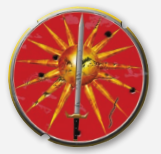
Medieval England/France in space. They're the default, kinda-sorta good guys.
Free Worlds League (House Marik)
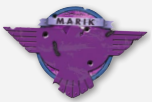
The United Nation in space. Easily the most democratic of all factions, but this also means lots of bureaucracy and bickering, which was certainly not helped when it turned out House Marik was ruled by an impostor for quite a while.
Lyran Alliance (House Steiner)
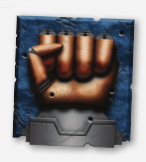
Space Germans, of course culturally regressed a couple centuries like everyone else. They are the industrial powerhouse of the Inner Sphere with the highest concentration of heavy 'Mechs and other vehicles. They also really need this tonnage advantage because their officer ranks are mostly filled by "Social Generals", inept morons who solely got the position because of connections and/or cash. They are not easy to take seriously.
Just before the Clan Invasion, the Houses Steiner and Davion formed an alliance to create the Federated Commonwealth. This little liaison turned into a civil war sometime after the Clan Invasion (the conflict of the MechWarrior 4 video games), but at least it lasted long enough to have the Lyrans adopt an officer recruitment policy that was actually sane.
Free Rasalhague Republic
The first faction that isn't run by a Great House. They are primarily Space Scandinavians with a track record of getting owned a lot, first by the Draconis Combine and then by the surprise Clan Invasion. At least they eventually fused with one of the raddest Clans out there.
Minor Periphery
Some of the smaller dirty Periphery peasants, ranging from a single to only a handful of worlds. Nothing to noteworthy here.
Major Periphery State
The big players in the Periphery, with some rather interesting fellows (which are sadly not fleshed out in this book itself):
- Magistracy of Canopus: A martriarchy with Blackjack and hookers. Wut.
- Marian Hegemony: Space Romans, using so many ancient Roman terms and lingo its not funny anymore.
- Outworlds Alliance: Founded by refugees and rather peaceful, which is pretty rare in this setting.
- Taurian Concordat: These guys are pretty well-equipped and trained for a Periphery state.
Deep Periphery
The most backwater non-Clan humans. The only noteworthy faction here is the Hanseatic League, which are unsurprisingly traders and merchants.
The Clans
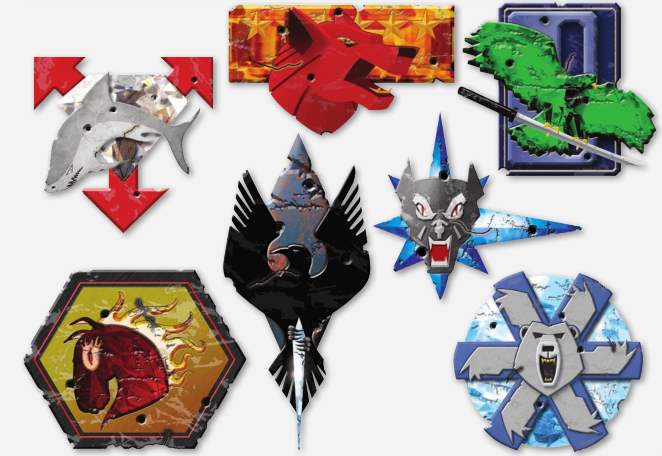
Sadly no Thunder Cats.
These are divided into Invading Clans and Homeworld Clans. The latter does actually include Clans that were part of the invasion, but didn't actually take over Inner Sphere worlds to rule over.
As mentioned earlier, the Clans are a caste-based society where the warriors rule unquestioned. This caste also deals heavily into genetic modifications, with most "proper" warriors being Trueborn, aka genetically enhanced humans grown in an artificial womb. Normal dudes exist in the warrior caste, but these Freeborn fellows have a very hard time.
The Warrior caste likes indulging in honourable duels, often to fight for the right over a Bloodname, one of the surnames of the Clan's Star League ancestors. Some of these Bloodnames exist in multiple Clans, while the more prestigious are exclusive to a single Clan.
Trueborn Clanners are also the only instance of a kind of "race" choice, or more specifically a Phenotype choice: a MechWarrior is your typical 'Mech pilot except with better reflexes. The Aerospace Phenotype has even better reflexes and is optimized for high-speed dogfights, but is oddly light and brittle for its size. Finally we have the Elementals, scary-looking shit brick houses who fight in Battle Armor aka heavy power armor that more often than not looks a bit fat and goofy, and reminds me of early Zeon Mobile Suits (especially the Z'Gok).
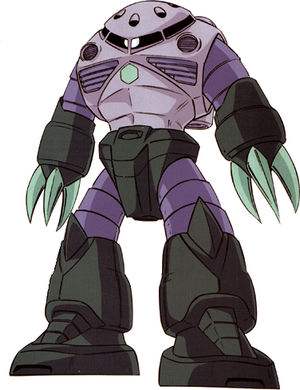
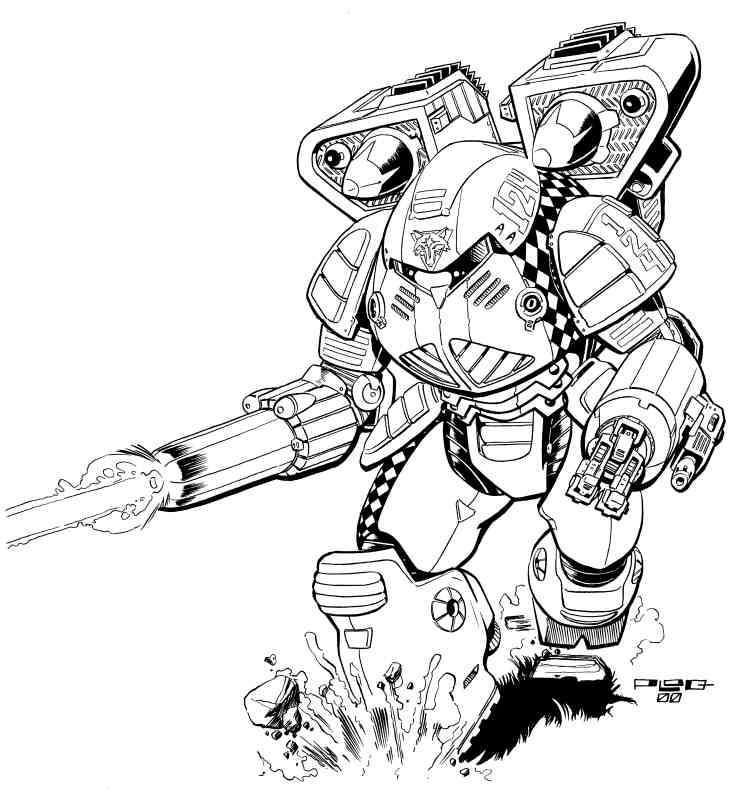
I love these guys.
Another goodie these suped-up Clanners get is a Field Aptitude, a special Trait that reduces the Target Number for all Skills relating to their combat training by 1. This reflects their boardgame shtick of having lower (aka better) skill ratings by default.
There's also a funny naming convention going on in that (almost) every Clan is named after some cool animal from their homeworld, which are all some funky variation of a normal Earth animal (BattleTech isn't too big on alien critters that actually are alien, but they do exist). I'l just offer some interesting titbits about a few of these Clans:
Clan Diamond Shark probably has the most hilarious story regarding their name. They were originally known as Clan Sea Fox (with said sea foxes looking like lame animal hybrids from an uninspired D&D monster entry) until a rival Clan decided to piss them off by releasing their newly-created diamond sharks (literally described as a "white shark on steroids") into the Sea Fox's oceans, driving this weird D&D monster to extinction or at least near-extinctions. Instead of getting pissed off as planned, the Clan just went "Man, these sharks are awesome!" and rebranded themselves.
Clan Ghost Bear is the above named raddest Clan. They actually give a damn about their normal citizens, so much so that nothing makes them go berserk quite like bombing their normies. They also integrated themselves quite well into the Inner Sphere, and they would later fuse with the Free Rasalhague Republic to create the Ghost Bear Dominion.
Their titular ghost bear is a big, sneaky predator that looks something like a cross between a yeti and a polar bear. The Clan's warriors supposedly have to prove their worth by killing one of these critters on with a spear or something. I'm really looking forward to the Companion book that has actual stats for a ghost bear to see whether this is actually possible.
Clan Wolf gets away with having a lame name by being Kerensky's Clan. Arguments on whether or not to invade or protect the Inner Sphere was especially fierce within this Clan, so much so that its protective members split into Clan Wolf-in-Exile.
Others
After this, the books goes back to the Inner Sphere again. Terrans are better (and more expensive) than everyone else, Comstar and the Word of Blake are more like a template you slap onto your actual origin, and we also get the Independent faction for all your mercenary and pirate needs.
Example Character
So the example character for this review will be Shunsui Hikari, a young MechWarrior from the Draconis Combine with daddy issues.
Naturally, the Affiliation will be the Draconis Combine. For the Sub-Affiliation, I pick the Benjamin District. Its wiki entry is a wall of text lacking a kind of summary, but I'll just take it because every other Sub-Affiliation adds XP to Willpower (and we can't have that with our spineless pilot) and because the Benjamin District has the hilarious negative Trait Paranoid of Combine Government, which is just perfect.
Characters of the Combine also get a bit of flexible XP to spend on an archaic weapon skill. The obvious choice is Melee Weapons so he can use the almighty katana, forged in blood and folded a million times.
And with that, we have spen a mere 150 of his 5,000 XP.
Next Time: More modules to flesh out Shunsui's miserable life.
Character Creation Part 2 - MechWarrior High
Original SA post BattleTech - A Time of War
Character Creation Part 2 - MechWarrior High
So far, Shunsui Hikari has your standard Draconis Combine traits: He knows his way around Combine society, knows how to kick people and hit them with a melee weapon, and he is a bit on the poor side. He is also paranoid of his government (probably because his d-bag of a father is working for a shady government project), and he had the chance to pick between points in Combat Sense or Pain Resistance (because Space Japan). I went with the former, since it makes more sense for a young 'Mech pilot.
He also has to pay 850 XP for some baseline abilities: A bit of Perception, skills in one of his Affiliation's languages (I picked Japanese) and English, as well as a 1 in every Attribute.
I'm not exactly sure what's up with these Attribute XP. You get a couple here and there every other Module or so, but you'll easily spend 50% - 75% of your Attribute XP at the end. Oh well, moving on.
Stage 1: Early Childhood
This covers Shunsui's upbringing up to age 10. Aside from normal stuff like Blue Collar, White Collar and Farm, you might also be a Born Mercenary Brat, or you have the hard choice between Fugitive or War Orphan. The Inner Sphere - a happy place to be.
Since Shunsui's father is a mad scientist of sorts, I'll pick White Collar for 170 XP. He trades some physical Attributes for more points in mental ones, has more cash to play around with, and he gets Glass Jaws. Because he's such a wimp. He also made an Enemy, because he's very punchable I assume.
stage 2: Late Childhood
This periods marks the his teenage years, ending with him being 16. It has a few more advanced forms of a couple of the latter Modules, and it features a few important education choices in the form of the High School and the Military School. I go with the latter because Shunsui's father probably put im in a boot camp / military boarding school the first chance he got, in hopes of him becoming less of a wimp.
This of course gives him several Traits and skills revolving around strategy, combat and fitness. He also needs to have a WIL of at least 3 by the end of character creation. He also gains his first military ranks. And all this for 500 XP.
Stage 3: Higher Education
The first optional stage of character creation, and one that can be taken multiple times. It offers a choice of various kinds of colleges and academies to gain proficiency in certain jobs, like technician or policeman. Several of these choices come in basic and advanced form, and other choices build upon them. An example for this is Officer Training, which offers nifiter military ranks.
The most important thing about Higher Education is that the skill packages offered here come with a 20%ish rebate, so we'll definitely hang out for basic, advanced and officer training.
Since Shunsui's supposed to pilot a big stompy 'Mech, he gotta go to Military School. Since MechWarrior training is an advanced training be default, we don't have choice here and stick around for 2 years total.
For a total of 1,130, he becomes a full member of the military and finally learns how to pilot a 'Mech, and XP pouring into his Martial Arts and Small Arms skills are starting to add up quite nicely.
Now for another year and 700 XP, Shunsui goes to Officer Candidate School for more sweet skills, and access to officer ranks which will eventually allow him to order other dudes around.
He has also gained 350 Flexible XP from that little military trip. Flexible XP are just part of a Module that haven't been assigned to anything specific. They sometimes come with restrictions as to how many you can spend on what, but these right here can be put on anything. Not entirely sure why they couldn't just reduce the Module cost, but whatevs.
These points will go into getting rid of Glass Jaws. As much as it might fit his wimpy nature, suffering +50% damage from everything (even +100% if its nonlethal) doesn't sound like a very good idea. We don't want him to break open his skull like an egg the first time his 'Mech falls down.
The remaining flexible XP go into getting our first points in the Vehicle Trait, which is a pretty fun one. The higher its level, bigger the 'Mech, tank or other vehicle you want to start out with. A minimum of level 2 (200 XP) is required to start with a Light 'Mech (20-35 tons), and a level of 8 (800 XP) gets you access to an Assault 'Mech (80-100 tons).
It should be noted that you're blowing all these XP on your starting 'Mech. If it gets blown up, you have to either buy a new one (good luck with that considering their price range), or ask your higher-ups (aka the GM) to assign you a new one.
But that's not all! You can even throw more XP at your 'Mech to give some positive Quirks (like say less heat generation on a laser weapon), or being able to actually pick the 'Mech you want instead of rolling randomly on a table. And if you want to have your character pilot a 'Mech you've designed yourself, that'll cost you another bunch of XP.
Stage 4: Real Life
These Modules reflect your adult life experience after your formal education. Did you have a civilian job? Did you serve in the military for a few years? Or were you just aimless? These Modules got you covered.
As for Shunsui... nope. As already way too old at 19. Better get him to the front lines ASAP.
Sample Characters
Now since this was a bit short, enjoy the best of the sample characters:
MechWarrior
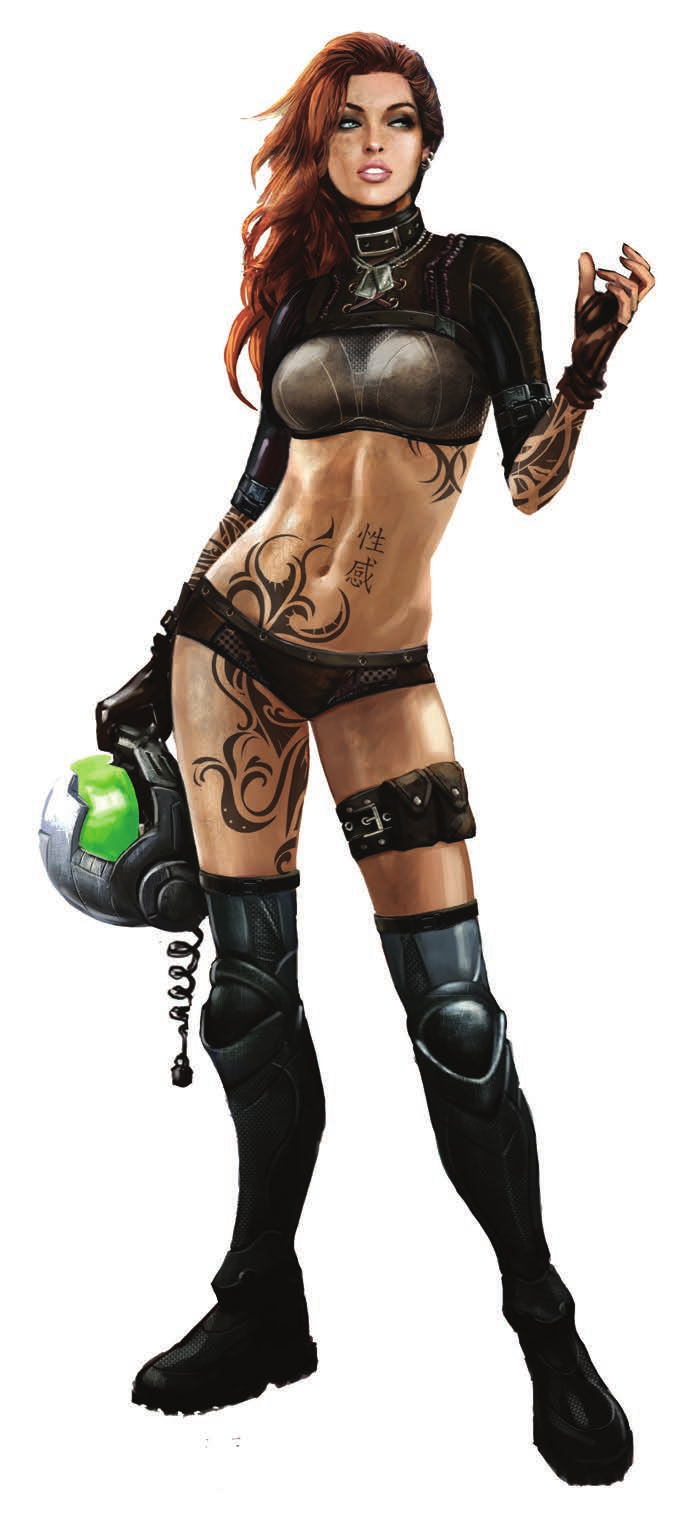
The thing about BattleTech is that it actually cares about heat generation - at least if your vehicle is important enough. 'Mechs and AeroSpace Fighters do for example, but lowly tanks and other boring stuff just has to be built so that it always cancels out any heat it might generate.
With that in mind, it makes sense for a 'Mech's cockpit to be located in the frail but small head of the 'Mech, as putting it right next to the fusion reactor in the torso might not be a good idea. As the cockpit still heats up a lot (BattleTech fiction loves describing this), the standard MechWarrior "uniform" is basically underwear with heat-insulated boots. Oh, and a cooling vest, but that's on the picture for obvious reasons.
AeroSpace Pilot
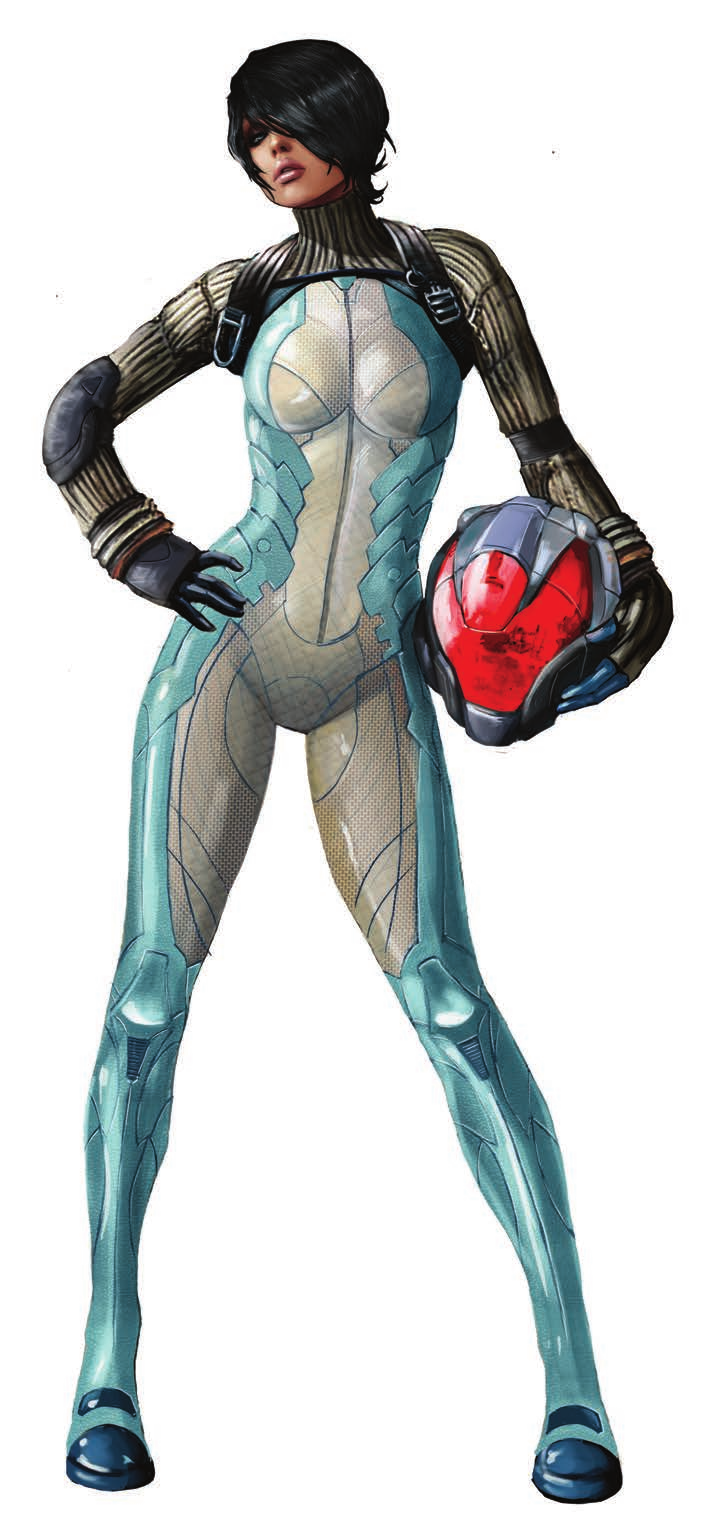
Meanwhile, AeroSpace pilots wear standard Animu mecha pilot getup so they don't die instantly if they ever end up in the cold vacuum of space.
Elemental
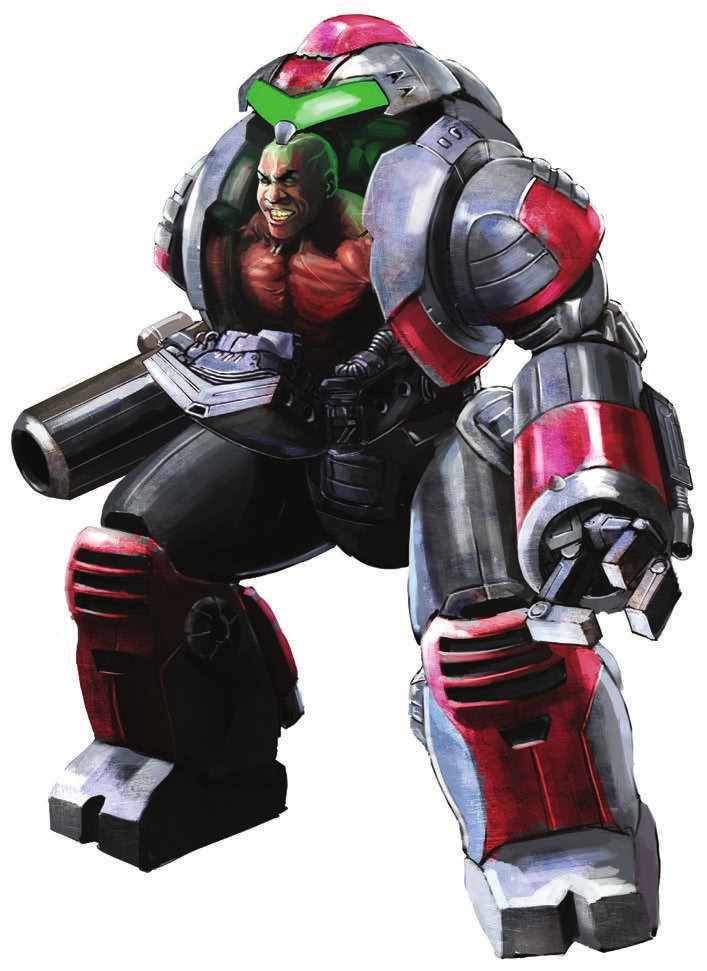
As it turns out, Elemental Clan Warriors have been genetically optimized to make the perfect rape face.
Scout & Renegade Warrior
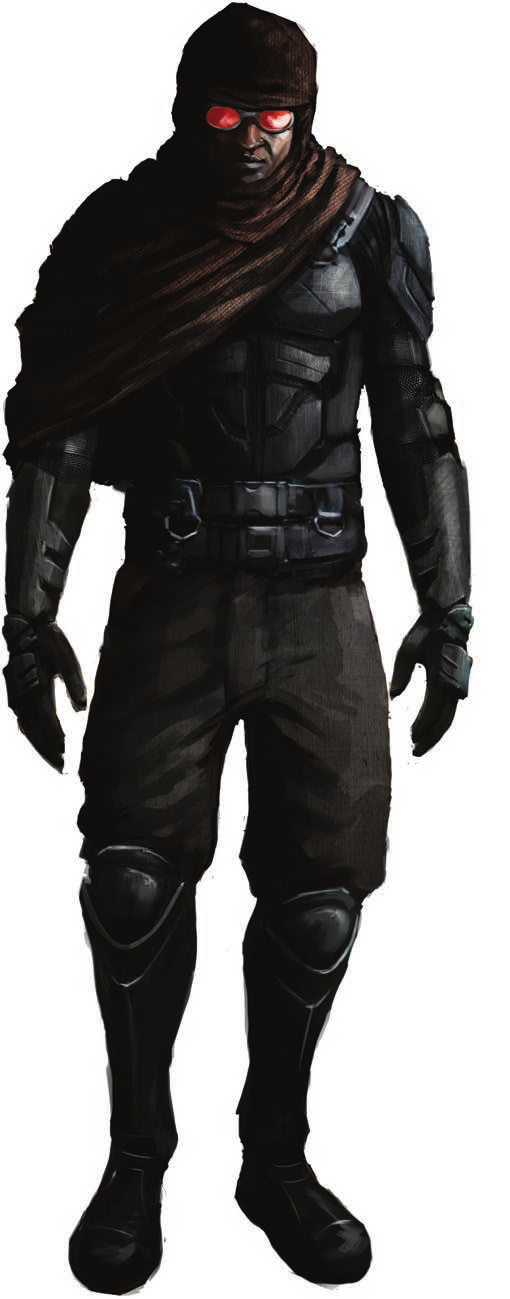
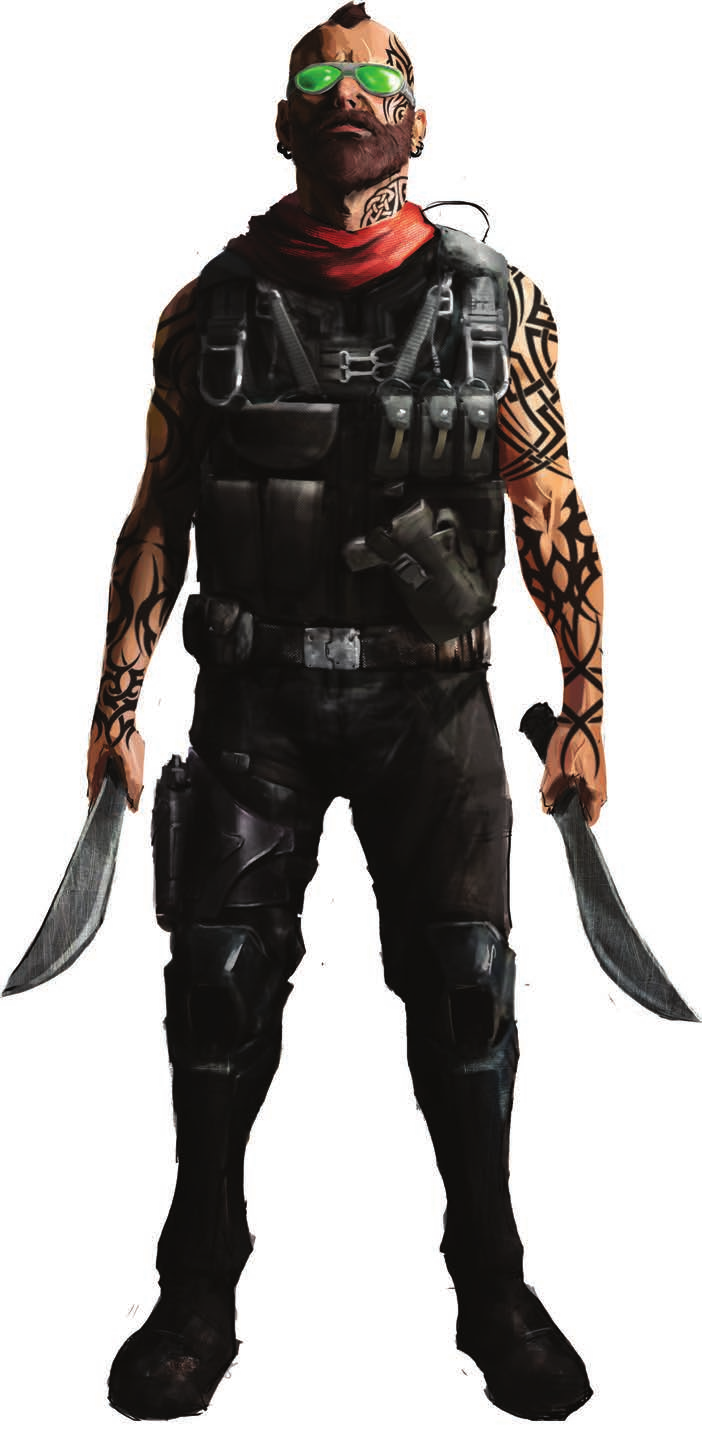
Just putting these two together because this might be the first game with two Not-Riddicks.
Your BattleTech Infodump of the Day: Spaaace!
BattleTech's FTL drive of choice is called the KF Drive, aka the
The KF Drive works by taking a shortcut through a higher dimension, similar to how one would take a shortcut by jumping over a wall. To an outside observer, these JumpShips appear to perform a near instant teleport.
Jumping comes with its fair share of limitations: You can't jump farther than 30 light years at a time, and your ship can deviate up to several thousand miles (if not more) from its intended destination. And unless your ship comes with a big battery for another jump, you have to unfold a massive solar sail and wait for a few days to recharge. If you're lucky, the system is important enough for nearby trade that there's a recharge station nearby.
Since KF Drives don't really work under gravity influences (or at least you really, really don't want to risk a jump under these conditions), the classic "jump points" for a JumpShip are the far north and south poles of a system.
There are also Lagrange Points, aka regions inside the solar system were the gravitional forces of nearby planets cancel each other outs. Considering their small size, the fact that they move around and might even disappear for a while, and the large margin of error when jumping means these are only really used by criminal elements, earning them the name "pirate points".
In the early days of FTL travel, JumpShips were these big, hulking behemoths. Then ship designers reduced them to their main drive, crew quarters and docking ports for the DropShips that would then carry the actual cargo.
DropShips are your main big ship for in-system business. They transport cargo, troops or just lots and lots of weapon systems. The classic DropShip is spherical in shape (aka mighty space eggs), but there are also Aerodyne DropShips who look a bit like oversized space shuttles. They have naturally a better maneuverability in atmosphere, but they can't into VTOL unless you want to risk some serious damage. Despite this, they actually do have a belly-mounted engine for space travel, so the interior doesn't have to be designed with gravity coming from two possible directions.
Below the DropShips are the Small Craft. They come in the same shapes and aren't terribly important, only really serving as shuttles and escape pods.
AeroSpace Fighters are called that way because they are all built for atmospheric operations. They aren't quite as maneuverable or fuel-efficient as conventional fighters, but they can just leave the planet if things get too hot for them. They also weight around twice as much as a conventional Fighter on any weight class, giving them a lot more guns to play around with.
As they can also get up to 100 tons, they are essentially flying 'Mechs.
There are also satellites and space stations, with the latter being extremely rare after everyone in the Inner Sphere bombed each other out of the Golden Age.
Next Time: Traits - it's Merits and Flaws time. Also time to roll up the starting 'Mech, or should I build one?
Character Creation Part 4 - Attributes & Traits
Original SA post BattleTech - A Time of War
Character Creation Part 4 - Attributes & Traits
So with the Module portion of CharGen over, its time to optimize your XP distributions. After going through all those Modules, pretty much all of Shunsui's Attributes, Traits and Skills are a couple XP away from their next full level. He can leave it at that, or free up some XP to reduce the XP Pool in question to its next lowest level. He can also completely remove unwanted Traits that are too many XP away from their first actual level.
As for negative Traits, he has to further go into the negatives until they've reached their first level.
On top of that, his military Modules also come with certain minimum Attribute scores, and his Edge Attribute has gone into the negatives, but requires a minimum investment of +100 XP like every Attribute. With that out of the way, he currently looks like this:
STR 1
BOD 1
DEX 4
RFL 4
INT 3
WIL 3
CHA 3
EDG 1
A bit dreadful considering that 4 is the lowest level at which you no longer gain a penalty to your roll (not to mention that he'll instagib at the slightest provocation), but as mentioned, Attributes aren't finalized until later.
Traits also come in different levels - called Trait Points (TP). All TP are worth the same, but Traits only have a handful of TP totals were they actually do anything. Having Good Hearing for example is just 1 TP aka 100 XP, while having a Sixth Sense requires 4 TP.
Now lets look at the Traits Shunsui has gotten himself during his career...
Combat Sense is an expensive little bugger (requiring a total of 4 TP) that improves Initiative rolls and offers bonuses in stressful out of combat situations and to resist getting stunned or surprised. As Shunsui only has +100 in it and is running a bit short in XP, he'lll drop it for now.
Compulsion handles anything from little personality quirks (at -1 TP) up to outright insanity (-3 TP and beyond). Shunsui has two of them at -1 TP, one for his xenophobia and the other for his paranoia towards his own government. A very conflicted fellow indeed.
Connections means that you have, well, connections. You can use them to get some intel, cash or equipment.
Enemy is sort of the opposite of Connections, in that there is an NPC or group of NPCs that is more or less directly working against you. An Enemy is always stronger than the character this Trait has, and at Shunsui's -1 TP, he or she has +20% more XP.
Equipped determines a character's access to personal equipment, which is rated in Tech Level, Availability and Legality. This is also one of those Traits that typically only do something at character creation, but the book helpfully tells us that this doesn't have to be the case. Yay~.
As Shunsui has more TP in Equipped than Connections (2 vs 1), he generally won't need use his Connections to get guns and stuff. Then again Equipped only really does something at character creation...
Extra Income means a character has some investments, properties or whatnot going on that provide a steady stream of monthly income. Having this at negative TP denotes a debt of some sort. At 1 TP, Shunsui earns 250 C-bills on top of his MechWarrior salary (which is somewhat around 1,500, but the exact calculation is later in the book). He certainly doesn't need to worry about buying replacements for his personal weapons with that much cash.
Fit grants the character extra endurance. He gains an additional modifier to rolls featuring STR or BOD, and he suffers less Fatigue from strenuous activities. He only has +15 XP in it and would require a total +200, not to mention that it doesn't fit his character. So away it goes.
Patient Grants a bonus to checks where one has plenty of time to focus and concentrate. Sounds alright and not too expensive to active it (he has +25 XP and needs another 75 XP), so we'll keep it around.
Rank is a very important one for military campaigns. The higher the rank, the more a character has to say.
The exact rank depends on whether or not the character is an officer or merely enlisted. Clanners also have their own ranks without such a distinction.
Thanks to the officer school, Shunsui can take the Officer ranks, and he in fact needs a minimum of 4 TP to have the O1 Ranks, better known as Lance Leader (a Lance being a group of four 'Mechs). At 470 XP, he could easily bump this up to O2 (a Company Second), but that sounds a bit much for a 19 year old without much experience. Lets keep the partial investment so he can get promoted faster.
Reputation is self-explanatory, and can go both positive and negative. At 1 TP, Shunsui's is somewhat known.
Vehicle, is as mentioned last time, the dubious Trait that determines your starting vehicle - and only your starting vehicle. The supplement gives this more long-term utility, but I'm getting ahead of myself.
At +265 XP, Shunsui would only qualify for a Light 'Mech. As an officer and Lancer Leader, he ought to get something sturdier, so he spends another 135 XP to gain 4 TP, the minimum for a Medium 'Mech
Since it would cost way too much to actually get to pick a 'Mech or - heaven forbid - design one myself , I'll just roll on the Random Assignment Table (a BattleTech staple) for the Draconis Combine, which the book provides for any period around 3075. The result is...
WVR-8K Wolverine (55 tons)
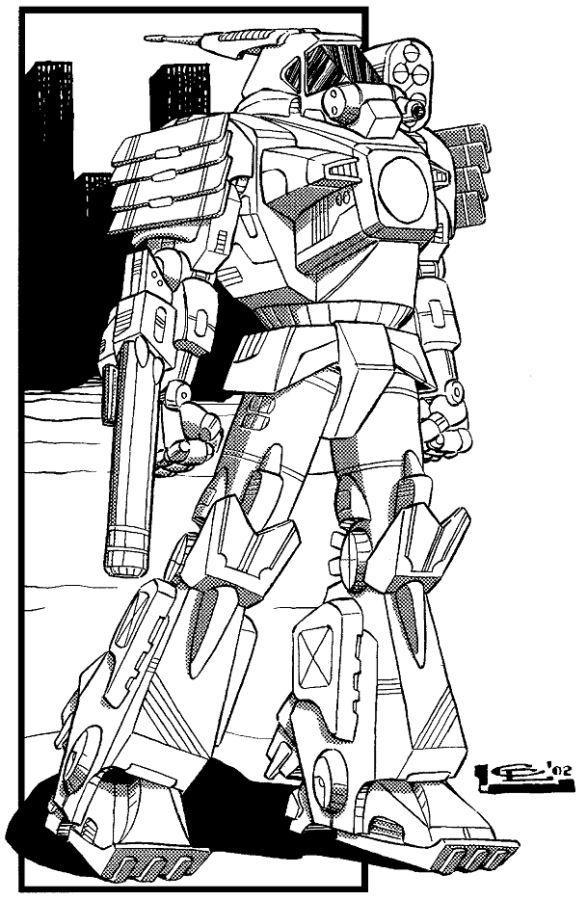
Now that's what I call a lucky roll.
A Combine-version (note the "K" for House Kurita in the name, and that samurai shoulder padding) of a 'Mech design originally created during the Star League era (a running theme for a lot of designs), primarily build around energy weapons. Its main armament are a PPC (Particle Projector Cannon) and a Medium Laser, both of the state-of-the-art ER (Extended Range) variety, offering some nice (but heat-intensive) punch at long to medium range.
For added oomph at short range, it comes equipped with a head-mounted Medium Pulse Laser (very handy for fast opponents) and a shoulder-mounted SRM-6 (Short Range Missiles, fired in volleys of 6) of the Streak variety (aka the missiles are only fired after a clear lock-on, avoiding wasted ammo). It also comes with CASE (Cellular Ammunition Storage Equipment), which prevents the whole machine from blowing up if a lucky enemy shot hits the missile storage. On top of that, it has quite a lot of armor for its category.
An ovious flaw of the design is that both of its long range weapons are located on the right arm. One blown-off arm later, and the pilot is forced to go into close range. Still, that's a pretty nifty result. And those 55 tons place it at the upper end of what is considered a Medium 'Mech.
Fun fact: The Wolverine is an example of a Reseen, one of those Anime license 'Mechs that disappeared from illustrations for years thanks to license shenanigans until they made a comeback with a new design. The Wolverine in this case was originally a Blockhead from Dougram.
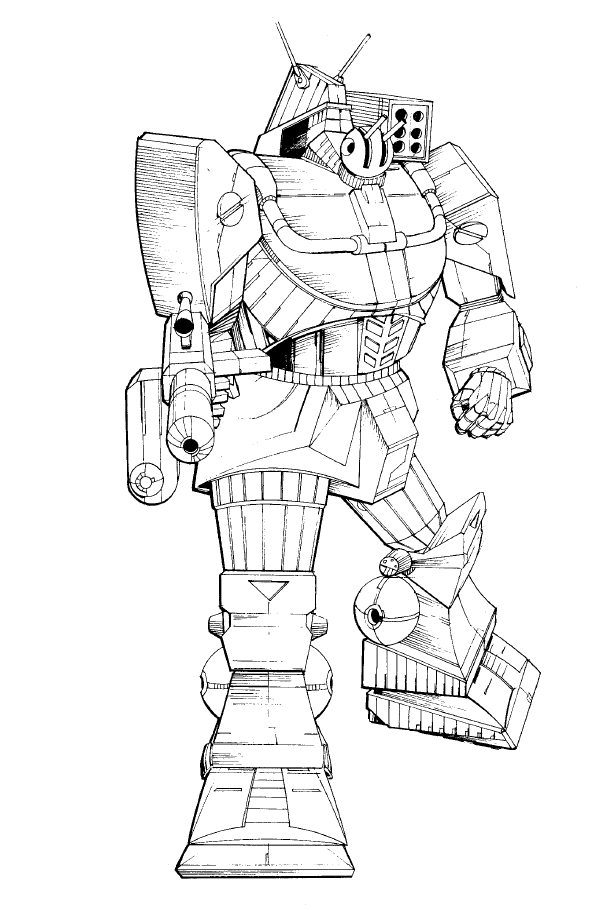
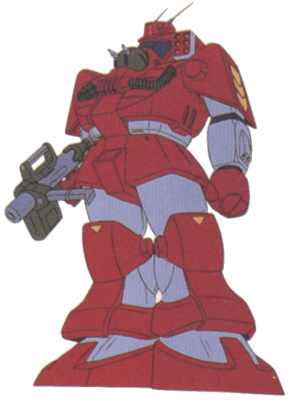
I like to imagine that the head turret was the actual head. Also know that actual handheld 'Mech weapons are so rare that whenever you see a 'Mech that appears to be holding a gun, it's actually just mounted to the arm.
Wealth is yet another Trait that only does something at character creation, namely modifying a character's starting cash. The default is 1,000 C-bills, but Shunsui's 1 TP give him 2,500. Combined with his Equipped Trait, he can actually aquire and buy his own set of MechWarrior gear (Cooling Vest, Neurohelmet, shorts and boots) instead of relying on whatever his higher-ups assign him. Officers got privilege.
He sadly can't start with a Vibrokatana (not Equipped enough), but he could get an ordinary one. Or a Nodachi, but that would be silly inside a cramped cockpit.
Other noteworthy traits Shunsui doesn't have (yet) include:
- Alternate ID: Provides the character with an alternate identity. Several Traits regarded fame, infamy, connections and wealth are tied to only one identity.
- Bloodmark: Congratulations, you've pissed someone off so much that there's now a bounty on your head.
- Citizenship: Some Inner Sphere factions (thankfully not the Combine) require this Trait before one is considered a proper citizen. The Clan equivalent is called Trueborn and makes you a member of the genetically-enhanced Warrior caste, allowing one to get a honorary Bloodname and hail from one of the Clan Phenotypes (aka be a super soldier).
- Combat Paralysis: The opposite of Combat Sense. Your Initiative is generally worse, and you suck in stressful situations.
- Custom Vehicle: Used to pimp out a vehicle. 200 XP let you chooce your starting vehicle, 400 XP lets you build it yourself. Clanners have to pay a couple hundred more XP.
- Design Quirk: Based on the optional BattleTech rule of the same name that assigns little benefits and drawbacks to a 'Mech and other vehicle, in order to give each model more personality. Again only applies to your starting vehicle.
- Exceptional Attribute: Allows a single Attribute to go slightly above the normal maximum, but doesn't actually raise it. Costs 200 XP and doesn't sound very enticing. You're probably bettre off buying more Skill levels.
- Fast/Slow Learner: Makes Skills cheaper/more expensive to learn. Slow Learner sounds like it'll seriously hurt in the long run, while Fast Learner at 300 XP is a bit expensive.
- Glass Jaw: Suffer at least +50% damage from everything. Avoid at all costs. The counterpart Thoughness reduces damage by 25% and is good to have on any soldier or Battle Armor pilot.[/b]
- Gremlins: Machines just love to malfunction in your vicinity for now adequately explained reason.
- Prosthetic / Lost Limb: Most kinds of implants and prosthetics in BattleTech don't make you superhuman, but rather just more or less cancel out the penalties you gain from having a lost limb or two. Prosthetics are ranked in Types, with Type 1 being barely better than not having anything at all (a hook, a peg leg, a glass eye), while Type 5 is pretty much just as good as the original body part. Clanners also have access to Type 6 prosthetics, which restore your limb via cloning. The process takes a long while however, so most Clan warriors just go with the quick Type 5.
- Introvert: You are shy and socially awkward. Definitely something Shunsui will get later in CharGen.
- Natural Aptitude: Pick a Skill, and now you make checks with it by rolling 3d6 and picking the two highest results. Not particularly worth it seeing how it costs anywhere from 300 to 500 XP, and Skills are generally cheaper.
- Transit Disorientation Syndrome: FTL travel makes you sick and dizzy, requiring up to 18 hours to fully recover. Now that's a nice one to give to Shunsui later.
- Unlucky: Grants them GM Anti-Fate points with which to screw the character over. Thankfully recommends to not actively try to murder the PC.
The Fires of Hell
Previously, the not-NPC of this ongoing story have met up and gotten theri assignments. They got pumped full of medicine so they don't end up like the Martians in War of the Worlds, and 'Mech otaku Franz got into some hilarious hijinks when he accidentally spilled some rasperry juice on Luella Hildebrand, a Lieutenant and MechWarrior assigned to this mission for reasons she herself doesn't quite get, but she's just following orders anyways. Seeing how the Lyran military is run by idiots, these reassignments must be pretty typical.
Anyhow, their target is the planet of Rochelle in the system of the same name, all under control by the Word of Blake (also nicknamed "Wobbies" by their enemies). Making use of a pirate point, they enter the system and make their way into the atmosphere with a shuttle.
Unfortunately for them, they get spotted by one to many fighter patrols and end up crashing down. Things are off to a good start.
Your BattleTech infodump of the Day
More Space!
WarShips are scary mofos. They can get pretty darn big and are filled to the brim with capital-scale weapons that can blow cities to smithereens and are generally the worst thing you can be bombarded with aside from nukes.
As KF Drives are very bulky frail, WarShips didn't really become a thing until Compact KF Drives became a thing, which as the name implies are a lot more compact. They also only make up round 42% of the ship's mass, as opposed to a regular Drive that gobbles up whooping 95% (JumpShips really are just a FTL drive with some additional bits stuck to them). With that little breakthrough, WarShips had ample space for heavy armor, weapons, hangar space, and of course docking rings for DropShips.
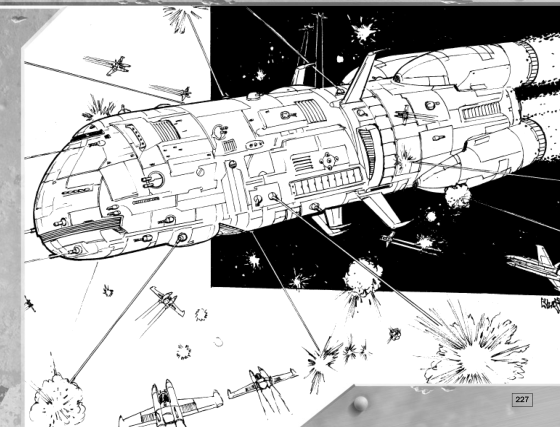
Being surrounded just means that you can attack in every direction.
As mentioned earlier, the first two Succession Wars had the Houses of the Inner Sphere blow each others' WarShip fleets to kingdom come. With no infrastructure to build new KF Drives (let alone the more sophisticated Compact version), WarShips went extinct (outside of ComStar's secret stash) for up until the Clan Invasion.
As with so much else, the Clans never lost the know-how to build WarShips. They where however of little importance for their military doctrine, preferring more honourable ways of battle than glassing everything from orbit. As such, advancements in Clan WarShip design are less pronounced than their are on the 'Mech side of things.
Around the middle of the Clan Invasion era, the Inner Sphere restarted their WarShip industry. Unfortunately, the sheer amount of time, manpower and resources required to build even a single WarShip meant they would never quite reach the prominence they had in the golden age of the Star League - especially not with the much more economically feasible alternative of the Pocket WarShip, a variation of the Assault DropShip (aka a DropShip armed to the teeth with weapons) carrying lots of WarShip-killer weapons, specifically capital missile launchers and later sub-capital weapons (scaled-down versions of the various WarShip guns that can be mounted on smaller vessels).
Next Time: Skills - do you know Kung Fu?
Character Creation Part 5 - Skills and 'Mechs
Original SA post BattleTech - A Time of War
Summer Sales are the worst. No on with the regular program.
Character Creation Part 5 - Skills and 'Mechs
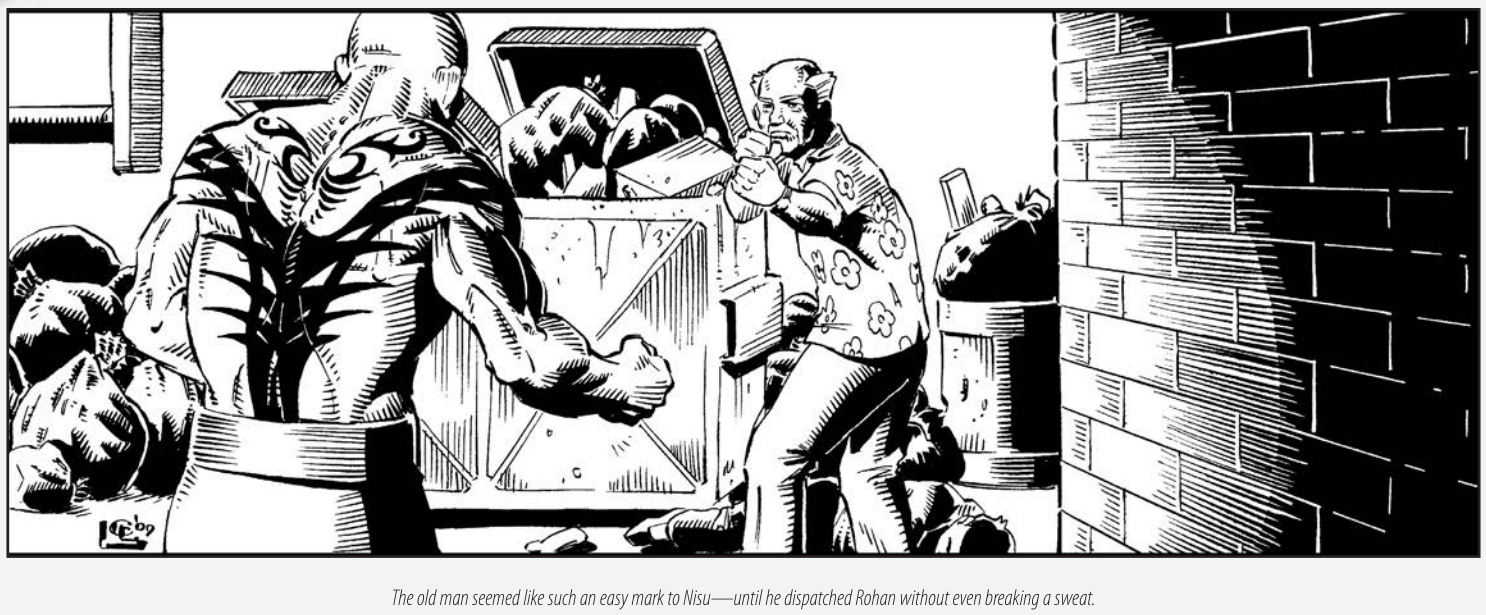
Don't mess with Mr. Miyagi.
AtoW's Skill system takes some getting used to. The provide your main source of bonuses to checks, though unlike most other Target Number systems, each Skill has its own TN, ranging from 7 (most combat and basic Skills) to (9 surgery and crazy hacking stuff). The higher and therefore more advanced ones do usually let you apply a second Attribute modifier, which helps out unless your other Attribtue is pretty darn low.
A Skill's TN is mainly derived from its Complexity Rating, a two-letter code denoting how easy it is to use in combat ( Simple or Complex) and how easy it is to train in ( Basic or Advanced).
Freshly purchased Skills also start at level 0, naturally with adding any bonus to your check.
Several Skills are just an umbrella term for a group of similar Subskills, like Gunnery or Piloting. You can also make up Specialisations for your Skills, but they are a bit restricted compared to other systems: They add to your roll if the check falls withing your chosen specialisation as you'd suspect, but they also subtract from checks that don't fall within it. So if you're dead set on showering the enemy with Macross Missile Massacres, your skills with more direct-fire weapons will suffer noticably.
Some Skills (namely Computers, Interest, Martial Arts, Melee Weapons and Prestidigitation) are Tiered Skills that upgrade into a more advanced version when they reach level 4. This represents the move from a more casual use of the Skill to something that is actuall trained. Are you a normal computer user, or are you an actual hacker? A history buff, or an actual historian? Do you simply know how to hit people with your fists or a sword, or have you formal training in a fighting style?
The main benefit of upgrading a Skill (aside from being necessary to keep leveling it up) is that you get do add a second Attribute Modifier to your Skill Checks, as it is standard for Advanced Skills. This can of course backfire if you're pretty bad at the new Attribute, either discouraging you from leveling up the Skill any further if you suck to hard, or power through the pain with more XP.
There are ove 50 Skills available, but it's thankfully hard to become a one-trick pony. A simple investment in the Small Arms Skill will cover pretty much every firearm you'll ever need unless you really have to use rocket launchers or BFGs, and the main difference between a MechWarrior and another combatant is that the former has two extra Skills (Gunnery/'Mech and Piloting/'Mech). A bit odd is the decision to split Throwing Weapons off into two Subskills, depending on whether you want to throw sharp things (knives and stuff) or blunt things (rocks and grenades). The strangest thing is probably a Subskill of Communications solely for Black Boxes, top-secret FTL fax machines from the Star League era, which you'll most likely never getting to use or even encounter unless you're playing a campaign of Star League espionage or something. That's an oddly specific skill if I've ever seen one.
In terms of God Stats, Dexterity is the obvious candidate as it is used for your piloting and any combat skill. Reflex also pops up in the advanced combat skills.
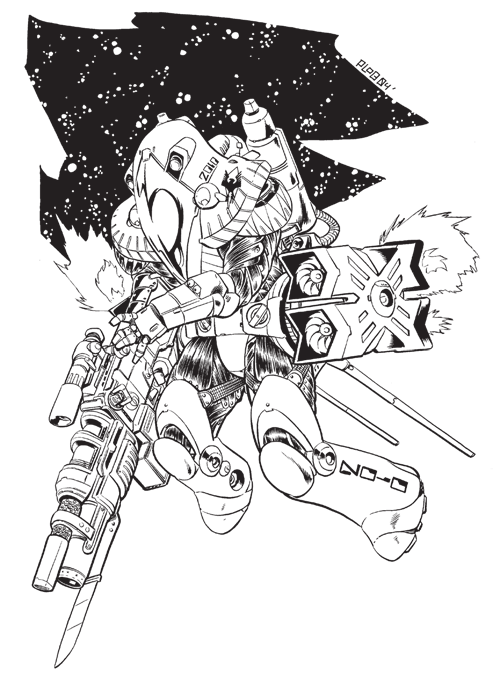
One of the few pictures in the book without any bit of descriptive text. Looks pretty rad for Battle Armor. Like Attack on Titan in Space.
The Skills themselves are straight to the point and self-explanatory, so let's look at what Shunsui has:
- Administration: Having this at level 3 means he's sadly not some weird Hikikomori living in his own trash.
- Art: Creative expression stuff. Shunsui gets "Oral Tradition" (Haikus?) by virtue of being from the Draconis Combine, and another set of point to be but either there on anywhere else. I chose "Drawing", because I like to imagine him doodling Mecha Musume versions of 'Mechs. Both Skills are at level 0 right now though, so he's not very good at it.
- Career/Soldier: It's D&D's Profession skill, used for anything that falls withing your Career as long as no other Skill would do the trick.
- Computers: Self-explanatory. He's far from being a hacker or actual programmer, which makes sense.
- Interest: Hobbies and stuff. He has "Military History" from his education, and he also ended up with points to be put anywhere else, more specifically "Holo-Games" (the video games of this setting) and "Anime & Manga" (I wonder if Case Closed is still going on).
- Gunnery/'Mech: Obivously used to spread death and destruction from his cockpit. Has a rather low starting level because he got it in a late module and didn't take further life experience, but he has plenty of leftover points.
- Language: He knows Japanese and English. As usual with this sort of skill, you don't actually make any checks, but the level rather shows or well you speak it. Both are at 0 right now, giving him one hell of an accent in either language.
- Leadership: Commanding people around. No surprise for an officer. Even starts at level 3, which going by the pregens seems to be the general level of competence for a starting character that is supposed to be good at it.
- Martial Arts: Punchung and kicking dudes. He's just one level away from actually knowing Karate, so I might just bumpb this up if I have leftover points.
- MedTech/General: Medical skills. As this game is kinda lethal, this is very handy to have around.
- Melee Weapons: Not quite as high as Martial Arts, so he's unlikely to start out with mad kenjutsu skills.
- Navigation/Ground: How to not get lost when walking or stomping around.
- Perception: Just like in D&D.
- Piloting/'Mech: The art of stomping around and punching other 'Mechs in the cockpit.
- Protocol/Combine: Etiquette stuff.
- Running: This improves his movement rate. A bit odd to have as a skill, but you gotta have some way to figure this out.
- Sensor Operations: How to make sense of beeps and boops.
- Small Arms: Covers any form of personal ranged weaponry that's not a bow or support weapon. Also at level 3, which is really swell.
- Strategy: The art of waging war. Only at level 0, but he's just starting out as an officer.
- Streetwise/Combine: Knowin your way around the mean streets of Combine. Did you know there are still Yakuza around?
- Swimming: How to not drown.
- Tactics/Land: Noticably higher than his Strategy level. Well, he sure knows how to fight.
- Technician/Weapons: There are a variety of Technician Subskills (including Electronics and an entire Subskill just for Myomers), but weapons sound about right.
- Training: Very handy to have for everyone in the party, as it allows them to teach each other Skills the others are lacking in.
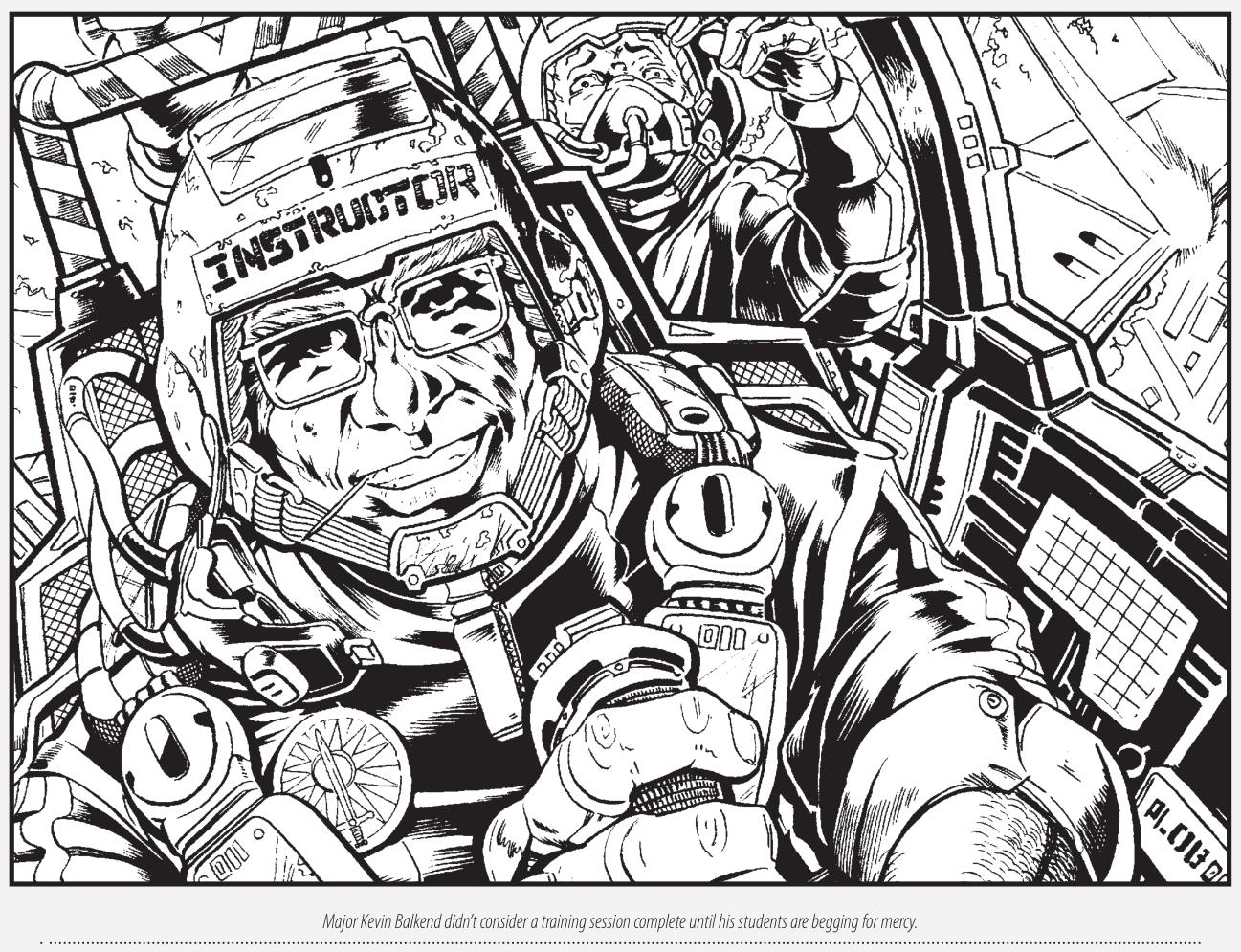
I love this guy.
And with that, he's almost ready to go. Just need to spend a couple more XP, maybe add a few flaws, and go shopping for starting equipment.
the Fires of Hell
Things go very, very wrong for our little Lyran recon party. Their crash landing thankfully didn't kill anyone of them (though some are in bad condition), but they are are far away from any sort of local resistance, and the Word of Blake is probably sending a crapload of troops towards their direction.
Thankfully it turns out that the WoB consists of far more militia simpletons than rad killer cyborgs, so they survive their first engagement. But to the surprise of no one, the only pacifist of the group is forced to kill a Wobbie in self defense.
Your BattleTech infodump of the Day (Deluxe Edition)
'Mechs
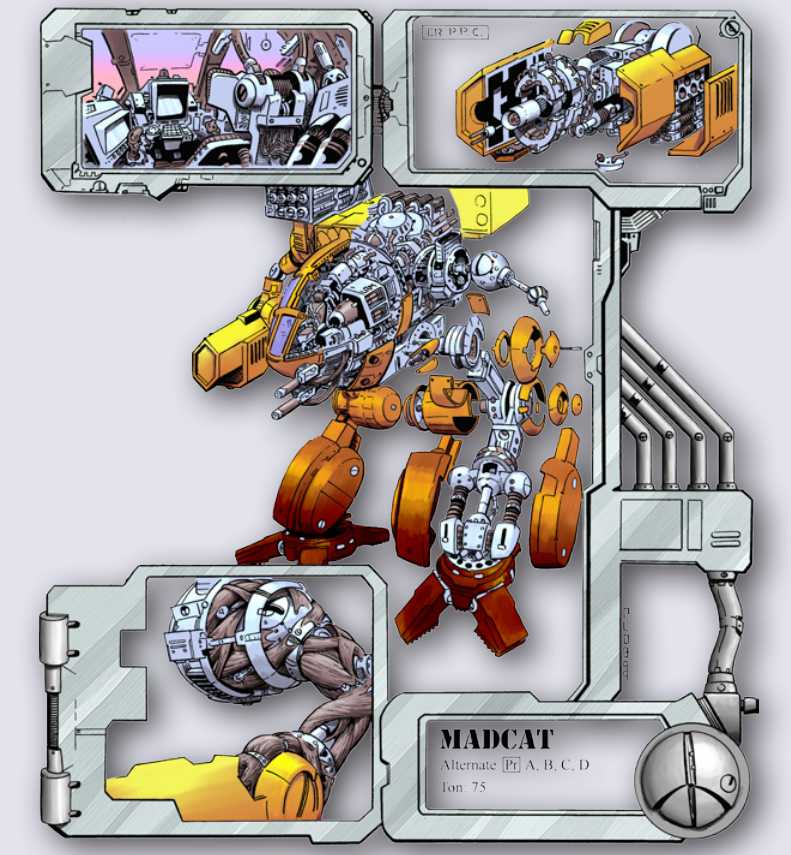
It's like the designers of this one were just asking for cockpit hits. Still the most iconic 'Mech of the whole game line.
(Confusing fact for BattleTech n00bs: Pretty much all Clan 'Mechs have two different names, with the Inner Sphere designation being the default. The iconic Mad Cat is actually the "Timber Wolf". Its Inner Sphere name came about because Inner Sphere targeting computers couldn't decide on whether this strange unkown 'Mech looked more like a Marauder or a Catapult and kept flip-flopping between the abbreviations for both.)
About time I talk about the iconic BattleMechs of this setting. About 12ish meters in height, with four weight classes common to several other vehicles in this setting (with weight typically increased in 5-ton increments): Light 'Mechs (scouts and skirmishers) are between 20 to 35 tons, Medium (grunts and the general backbone of any army) between 40 and 55 tons, Heavy (frontline fighter or heavy weapons platform) between 60 and 75, and Assault (essentially slow wrecking balls with guns) between 80 to 100 tons.
BattleMechs between 10 and 15 tons exist and are classified as Ultralight, but are exceedingly rare as their low capacity for weapons and armor makes them ill-suited for actual combat, generally relegating them to ceremonial duties or escorts for ambassadors and other politicians.
BattleMechs that go beyond 100 tons (up to 200 tons in fact) are called Superheavy. They are big and extremely slow, but can take quite a beating and dish out some serious hurt. Due to the difficulties of producing them (the first attempt during Amaris' little terror regime resulted in a hilarious failure that couldn't actually move without breaking its legs), they didn't reach any sort of mass production status until the Dark Age era of the 32th century. Even then, those SuperHeavies are generally at most 135 tons heavy, with the last 200 ton behemoth being an April Fools joke turned serious that the Word of Blake used in one of their last engagements.
All BattleMechs are build with an internal structure serving as the "skeleton", with myomers to provide muscles and layered composite armor to provide protection. A heavily protected fusion reactor serves as a near unlimited source of energy. Add some environmental sealing and enough rations for a week or two, and a 'Mech can operate for extended periods with little issues.
Unlike what the various video game adaptions like to show, a 'Mech's fusion reactor can't actually explode (unless playing with an optional rule solely for those who want those kabooms), as fusion energy is hard enough to maintain in the first place and will fizzle out if the reactor is breached for good. From a campaign perspective, this also helps with the salvage philosophy of BattleTech, where the winner of a battle likes rounding up all the enemy wreckage for loot. Salvage rights are a hotly-debated topic whenever mercernaries are hired.
What can explode is the 'Mechs ammo storage, and any 'Mech outside of those using energy weapons exclusively likely carries enough ammo with it to overkill itself three times over if its ammo is hit. This is why the CASE system is omnipresent pretty much anywhere outside of the Succession Wars (where the technology was lost like so many others), as this system vents off the explosive energy through one of the side torsos, protecting the main torso and preventing a lucky shot from starting a spectacular chain reaction.
In order for a 'Mech to not topple over all the time, they are outfitted with a heavy gyro located in the torso, which is linked directly to the MechWarrior's sense of balance via his Neurohelmet. Older aka more advanced models of this helmet might offer additional benefits, be it better feedback of the 'Mechs posture or a virtual reality simulation of the surroundings. The downside of this his that the helmet occasionally zaps its wearer through feedback generated from ammo explosions and other catastrophic events.
A particularly deep connection between man and machine is the Direct Neural Interface, which let's the MechWarrior feel his 'Mech as if it was his own body. Unfortunately this interface was deemed a failure, as any MechWarrior using it for a longer period of time has a habit of going batshit crazy (both because of the interface itself and because of the drugs required for it). Though this didn't stop the Word of Blake from using a modified version for their cyborg MechWarriors (who are already pretty batshit to begin with).
Probably the biggest flaw of the 'Mech design is its head cockpit, a very vulnerable location regardless of tonnage. It is for this reason that weapons capable of one-shotting a 'Mech head are very scary, and the BattleTech rules have always been a bit prohibitive when it comes to called shots against the head (which in turn serves as a flaw for most accurate video game adaptions, as multiplayer matches generally tend to boil down to headshots and more headshots).
Naturally, torso cockpits do exist, but they come with their own share of flaws: They are very cramped as there are already a lot of vital components inside the torso, adding a slight penalty to the piloting. A lack of windows also makes the MechWarrior blind as a bat when his 'Mech's sensors take a hit. And most importantly, the close proximity to the fusion reactor means that things will get very hot very quickly if either the reactor or the life support gets hit. Consider then that escape pods are very tricky to implement (as opposed to head cockpits who on some models have the entire head serve as an escape pod), and it is no wonder that torso cockpits see little widespread use.
Mobility-wise, 'Mechs aren't any more faster or slower than a tank or other combat vehicle of similar tonnage. They are also much less agile to contemporary anime mecha, though they are more agile than what the video games portray. 'Mechs are no strangers to some good old fisticufs and other reckless maneuvers.
Several 'Mechs are also equipped with Jump Jets for what is essentially a controlled super jump. Jump Jets can also be used in space, but their low output and fuel makes this not advisable, as any dedicated space craft will just fly circles around a 'Mech. This is certainly no Gundam.
'Mech Weapons
'Mechs make use of the settings standard weaponry: Autocannons deliver glorious dakka to foes (with bigger guns somehow having a smaller range). They are also some of the few weapon categories where the Inner Sphere has a slight edge over the Clans, as they employ a wider variety of models and ammo.
Gauss Weapons are the mean big brother of the Autocannon, shooting magnetically-accelerated projectiles with both great force and range. They also have the advantage of non-exploding ammo, though the weapon itself can explode instead.
Missile Launchers are another staple, with the most popular being long- (LRM) and short-ranged (SRM) missiles, with the former being the primary method of indirect fire and the latter offering some nice close combat oomph. SRMs also come as Streak versions, which use an all or nothing approach: Either the launcher gets a succesful lock-on and hits with all missiles, or it fails to do so and doesn't launch any missile.
Lasers are another popular choice, trading in the fear of potential ammo explosions for massive heat generation (forcing the designers to install lots of Heat Sinks). They come in several sizes and ranges, and the most noteworthy variant are the Pulse Lasers whose high rate of fire grants them a very juicy hit bonus.
Overall, the venerable Medium Laser is probably the most commonly-installed weapon in the entire setting.
Particle Projector Cannons (PPCs) a very feared, being one of the most powerful long range weapons after the Gauss Weapons, and unlike said weapons they never became LosTech in the Inner Sphere. They do heat up a 'Mech like crazy, though.
As many 'Mechs have at least one hand, it is unsurprising that there are a couple melee weapons available aside from simple kicks and punches. The most popular choices include hatchets, swords and claws, but you can also get yourself a wrecking ball, a chainsaw (or even a dual chainsaw), or a friggin' drill (though the rules don't let you punch with the drill, resulting in pitiful damage). Since Clanners find melee combat dishonourable, they don't make use of these weapons, and often don't even put hands on their 'Mechs in the first place.
There exist other weapons of course, like the Machine Guns for anti-infantry duty (though I doubt they are very popular, as its ammo is so weight-efficient that even the minimum amount of ammo will really, really hurt when it explodes) or Flamers for extra heat generation, but these are the most important.
Something often poked fun at are the short ranges of BattleTech weapons. Those LRMs? Can barely reach a kilometer or so. This is of course the designers didn't want a wargame requiring a football field to play on, and put a focus on maneuvering and the occasional punch. In setting, the books like to point out how every given battlefield is spammed with ECMs and ECCMs, to the point that system actually providing either functionality must be especially good.
Of course, there are ways to subvert this. There are optional rules in place for an additional range band (or even plain line-of-sight range for long-ranged weapons), and any piece of artillery can shoot over several maps worth of range.
'Mech Variants
OmniMechs are a major variant of the standard 'Mech, comprising all but the earliest Clan 'Mechs and more and more Inner Sphere 'Mechs as time goes on. Their gimmick is that they are more modular in nature, with most weapons being installed in so called OmniPods, fancily-named hardpoints that can be quickly swapped out between missions. The downside of this technology (aside from making the 'Mech more expensive) is that larger OmniPod weapons installed on the arms require the removal of the hands. Though seeing how Clanners hate melee anyways, they probably never had any interest in fixing this little feature.
QuadMechs are an alternative to the humanoid standard 'Mech that trades in its arms for another pair of legs. They typically look either like a spider tank with too few legs or a grittier version of Zoids. They are very stable, can move sideways and perform mule kicks against enemies from behind. Unfortunately, their build prevents them from making torso twists, which allow their more popular humanoid brothers to greatly increase on of their arm's firing arcs. The advanced construction rules somewhat mitigate this by allowing QuadMechs to monut a proper turret, but they are still best served as mobile turrets that hide behind cover most of the time.
The Dark Age era had the Clans come up with a variant of the QuadMech: The QuadVee. In what I assume was an attempt to make tanks more attractive for Clan MechWarriors, they decided to build QuadMechs that could transform into tanks. Not only do they all come with a turret, but they are also piloted by two MechWarriors for improved multi-tasking, with one serving as the pilot while the other operates the guns.
Unfortunately, the transformation system takes up space and weight, and system damage can easily stop it from working.
IndustrialMechs are the civilian counterpart to the BattleMechs, coming in both humanoid and quad shape and with the same weight class (though Ultralight versions are much more common, so much in fact that they are just lumped together with Light IndustrialMechs). They can serve all sorts of purposes, be it construction, transport, woodcutting, or just taking care of very, very big cattle. They were very common during the Star League era, but went all but extinct for centuries after the Succession Wars made their construction and maintenance unfeasable. The general resurgence of lost technology shortly before the Clan Invasion helped them to make a comeback.
As they don't have to be build for military standard, IndustrialMechs use much cheaper armor, usually come with an open cockpit unless environmental sealing is absolutely required, and they typically avoid expensive fusion reactors in favor of cheaper alternatives, including combustion engines, fuel cells and friggin' nuclear reactors if you're feeling particularly crazy.
All these budget cuts make IndustrialMechs somewhat popular as a poor man's BattleMech, serving as the basis for militia, police and security forces. And of course, desperate situations or criminal energy can easily result in an IndustrialMech getting decked out with weapons.
Though not really exclusive to the Dark Age, it was during that era that Tripod 'Mechs saw widespread use (at least in the hands of the Republic of the Sphere). Not quite as stable as a QuadMech, their torso can rotate like a turret, whic combined with the way they move allow for very fast facing changes. Like QuadVees, they require a two-man crew. The Superheavy versions (which really all the canon Tripods are) of the Republic even come with a third MechWarrior who acts as the technical officers, who provides support for the rest of the Lance and tries to keep shutdown and critical damage effects to a minimum.
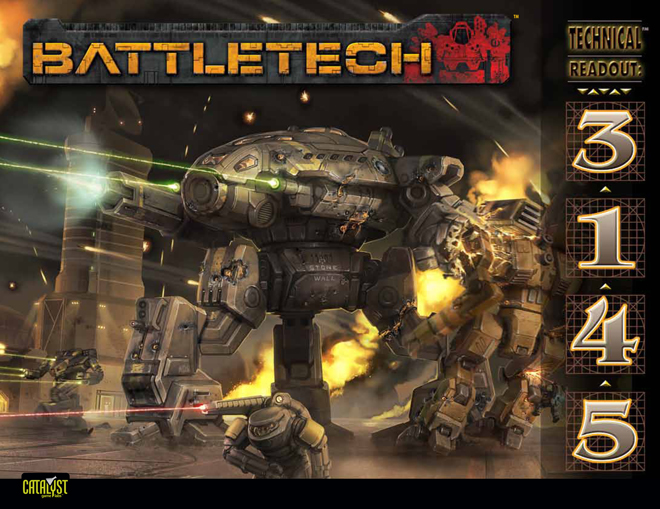
Out of my way, I need to beam spam some more. Also what's up with that dorky Battle Armor?
Seeing how mecha designs from Macross were used for a couple of the early BattleMechs, it is no wonder that they would also borrow the Veritech fighter. Enter the Land-Air 'Mech (LAM), 'Mechs with the capability to transform into an AeroSpace Figher and vice versa. The early prototypes couldn't transform in mid-flight, but later models made use of the LandAir (aka not-Gerwalk) mode to do just that. in this funky-looking mode, the machine flies via WiGE (Wing in Ground Effect, aka low-altitude flight for extra lift, aka gliding on steroids).
For all its flexibility, LAMs came with their fair share of flaws: the transformation mechanic was too delicate for anything heavier than 55 tons, and the extra mass dedicated to it made the LAM less efficient than a dedicated fighter or 'Mech of the same tonnage. Worse yet, the pilot had to be trained both as a MechWarrior and an AeroSpace Fighter pilot, which is a lot of time and resources spend for someone who is probably just barely average at both kinds of vehicles. Add in the loss of technology during the Succession Wars, and the LAMs eventually went the way of the Dodo. The Word of Blake had a short run of their own LAMs in the late 3070s, though they failed to accomplish anything but mild surprise.
Out of setting, LAMs seem to be disliked by a large portion of the player base for being both gimmicky, not very performant and appearing to be noticably more advanced than anything else in the setting. Still, a Star League campaign about MechWarrior SpecOps using their transformer 'Mechs to enter and leave their zone of operation sounds pretty darn rad.
ProtoMechs were born out of desparation. When the late Clan Smoke Jaguar saw itself getting wiped out by the forces of the Inner Sphere, its scientists came up with an idea to quickly replenish their dwindling MechWarrior supply at a budget: they designed extremely small 'Mechs (between 2 to 9 tons, with a height of around 6 meters) and put failed AeroSpace Fighter pilots inside them, mainly because they had a lot of them, only their frail physique fit into the very small cockpit, and the interface used was similar to the virtual reality interface of a Clan AeroSpace cockpit. To cut down any sort of training time, these new recruits controlled these ProtoMechs exclusively through a form of the Direct Neural Interface, with the "cockpit" essentially just being a small egg-shaped chamber that holds the pilot's body in place. Naturally, this eventually leads to insanity typical for this interface, but in the meantime the pilot can control the ProtoMech like his own body, making it dangerously agile and more akin to supersized power armor than a 'Mech. They are even the only kind of 'Mech that makes heavy use of handheld guns, giving them more punch for their tonnage.
For some reason, all ProtoMechs are named and designed after some mythological monster, and they are the only kind of Clan 'Mech that does frequently indulge in melee combat (though that's probably because the pilot is going a bit berserk).
The ProtoMech couldn't prevent Clan Smoke Jaguar's demise, but the technology quickly spread to the other Clans, even those that stayed in the Clan homeworlds (who would eventually come up with larger versions).
(And despite being easier to be trained in than being a MechWarrior, ProtoMech pilots still need the same two basic skills - Gunnery and PIloting -, just with different Subskills)
FrankenMechs are what you get if your 'Mech is beaten up and you can't afford and/or find the right replacement parts: Just slap on limbs and parts from other models.
Next Time: Combat - so how lethal is this?
Combat
Original SA post BattleTech - A Time of War
Combat
AToW closely mirrors the normal BattleTech rules when it comes to combat. This does mean it is one of those games where initiative is re-rolled every round, though you can just do it like in BattleTech and have each side only use one initiative roll. Though then you also have to adhere to squad coherence, and PCs that are too far away from the rest of the group have to use their own initiative.
Action economy is somewhat interesting in that you don't get the typical "You have 1 Standard and 1 Movement Action" thing. The actions you can take are either Incidental (more or less Free Actions, but you only get 5 at most), Simple (of which you have two) and Complex Actions (basically a fancy term to say "This takes your two Simple Actions"). Movement Actions exist under each group, and you can only ever take one of those modes of movement per Round.
What this means is that as long as you move no farther than Walking speed (an Incidental Action), you can use your two Simple Actions to attack twice per round. So once your safely behind sturdy cover and the enemy has no easy way of flushing you out, you are free to Dakka away at your leasure.
Mind you, Walking doesn't cover too much ground (the next fastest speed Run covers 10 more meters by default, with additional meters depending on your Running Skill), but it's a much more mobile alternative to the dreaded D&D 3.X Full Attack that forces everyone to only ever take baby steps.
Of course, you might not be able to cover your maximum distance depending on how rough the terrain is. And just like in normal BattleTech elevation changes cost you additional movement.
Attack
Action resolution is just like in BattleTech: The attacker makes an appropriate Skill Check (aka tries to beat a fixed Target Number) and applies a bunch of modifiers depending on range, movement, cover and others. If the defender has some levels in the Acrobatics Skill, he can apply a further penalty by sacrificing his actions and doing some barrel rolls.
Rules for indirect and automatic fire also exist, with the latter only being seen in normal BattleTech for special weapons and/or optional rules ().
Melee attacks are opposed actions, with the defender taking an action to dodge or parry. As both sides trie to both beat their own TN and get a higher Margin of Success than their opponent, a total of four outcomes are possible: the attacker hits, the defender either blocks or also hits, the attacker misses and the defender makes a counter attack, or nobody hits anything. A nice change from the typical binary hit/miss resolution. Grapling rules exist, but they only take up half a page.
Damage
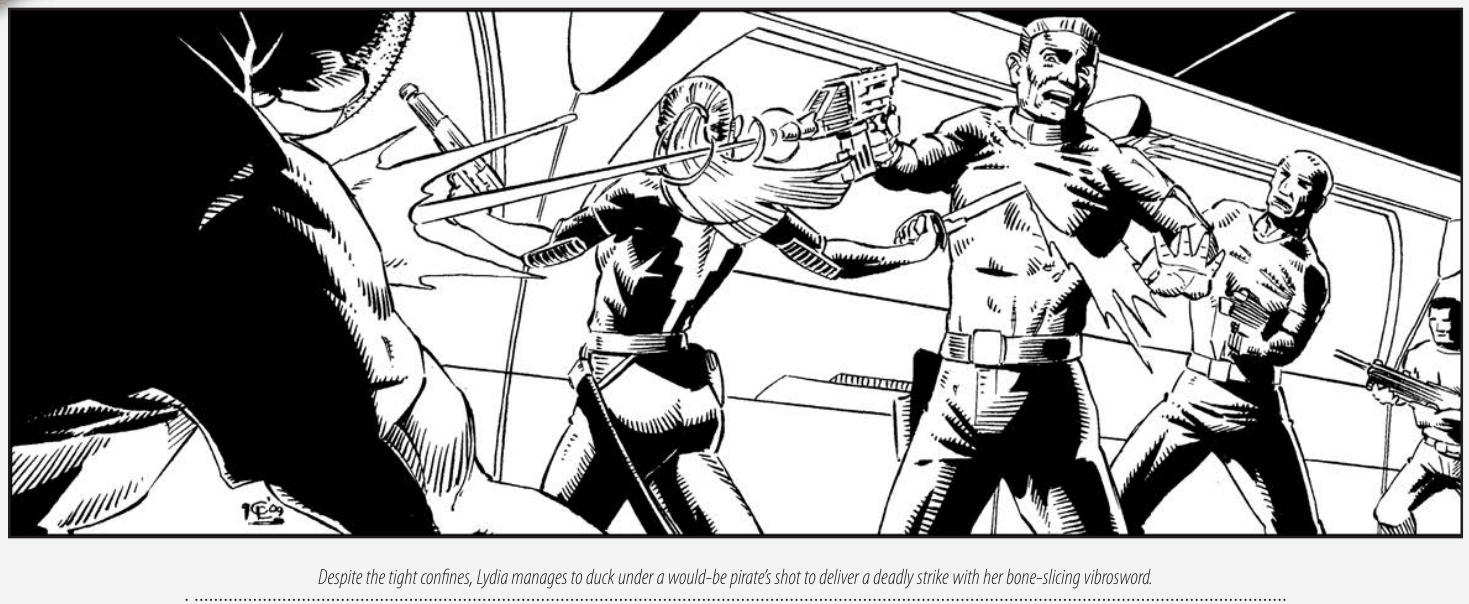
Ouch o_O
All weapons in BattleTech ocme with an AP (Armor Penetration) and BD (Base Damage) value. They also have a letter code similar to Skills, with one part of the Code applied to the AP value to denote the kind of damage that is dealt (since of course armor in this game has varying levels of efficiency against say Ballistic and Energy damage), while the other part is applied to the BD value to denote special weapon effects (like Area Effect or Burst-Fire).
The AP value is naturally subtracted from the target's armor rating, and any leftover armor reduces the incoming damage. For less lethal campaigns, there's an optional rule in place that makes just about any attack deal Subduing (aka non-lethal) damage when the attack fails to completely penetrate the armor.
Like in normal BattleTech, weapons deal a fixed amount of damage, though a high MoS adding extra damage. This is usually a more 1/4 of a damage point for each Margin unless burst-firing. This extra damage is rounded down for ranged weapons, but rounded up for melee attacks (because the latter is an opposed action, aka the other side can mess up your effective Margin). Melee attacks naturally also deal more damage depending on your Strength.
As mentioned way back, each character has a separate track for Standard and Fatigue damage, with the former being based on your BOD score, while the latter is based on your WIL. For your daily dose of death spiral, both point pools add their own share of penalties as they are depleted.
Both pools are mostly kept separete, though each instance of suffering Standard damage will also cause 1 point of Fatigue.
Each and every time a character takes Standard Damage, he has to make a WIL check to see if he falls unconcious. This is actually pretty handy considering the Standard damage rules are so lovingly oldschool that hitting 0 on that pools means instant death.
Also, whenever a character takes any kind of damage, he is stunned, which costs him one of his next Simple Actions. Harsh, but thankfully he still has another one do shoot with.
And when a character takes too much Standard damage in one shot, there's a chance that he might start bleeding for some nice ongoing damage that requires medical treatment.
Thankfully, both conditions are strictly binary and can't be stacked for massive stunlock or ludicrous DoT.
Armor
Every piece of personal armor comes with four BAR (Barrier Armor Rating) values, one for each damage types (Melee, Ballistic, Energy, Explosive). The weird term for armor points is derived from normal BattleTech, used for support and other non-combat vehicles with crappy armor that makes them more likely to suffer critical hits (and it's in fact the same kind of BAR under AToW). Proper military vehicles and 'Mechs technically also have a BAR rating (10 to be exact), but it's high enough to not come with any flaw.
Since BattleTech is all about ploinking abway armor points, we have rules for armor degradation, though personal armor has to be hit for quite a bit of damage before degrading.
The ablative armor points of normal BattleTech are called Tactical Armor under this system. To reduce this armor with personal weapons, you have to both penetrate the vehicle's BAR (which is up to 10 for a proper tank or BattleMech, only ever reached by the heaviest of Battle Armor) and divide any damage that goes through by that BAR. And unlike personal armor, vehicles will never have their BAR reduced.
Considering that even the heaviest anti-vehicle support weapon will likely only deal 1 point of Tactical Armor damage to a BAR 10 monstrosity, even a simple Light 'Mech can make for one scary encounter.
Battle Armor is somewhere between person and vehicle, and the wearer will only suffer damage itself if the armor loses more than one point of Tactical Armor in one shot. So if you can, go Battle Armor.
For a little example of the lethality of this game, an average person has a BOD and WIL of 4, giving him a Damage and Fatigue pool of 8. PCs and seasoned warriors probably won't at least one of those attributes at a 5 or 6, resulting in a pool of 10 or 12.
As a MechWarrior isn't exactly walking around in heavy armor, he'll likely only have a BAR of 2 at most. A proper soldier will likely have an average BAR of 4.
A generic ballistic auto-pistol (a fancy name for a semi-automatic pistol) has an AP/BD of 3/4, while a generic energy pistol has a 4/3. Your typical assault rifle has 4/4, though it will benefit much more from a MoS thanks to Burst-fire. Note that those AP values mean that one average, armor won't really do much.
Even with full Burst-fire, it will be very unlikely to one-shot someone. But all but the energy pistol have a very good chance of getting the death spiral rolling (even the auto-pistol will generate at least a -2 penalty on an average guy), plus possible bleeding. And the enemy is likely able to shoot twice. Just don't get hit, okay?
Optional Rules
AToW gets a bit oldschool with rules for morale, which can also affect the PCs. It puts additional importance one having at least one bloke with a good Leadership Skill Level to keep everyone focused, and adds another incentive to get a good WIL score because that's what Morale Checks use.
While standard BattleTech is all about hit locations, they are an optional rule here. Armor pieces are already divided in head, torso and leg locations by default, but without these hit location rules you only ever use your torso armor.
The hit locations themselves are similar to that of a 'Mech, and they serve to replace the standard death spiral penalties with location-appropriate ones.
The hit locations also come with their own damage modifier. Hands and feet cause relatively little damage, while a headshot naturally deals double damage. In the above example, even the auto-pistol could one-shot a guy.
For reduced lethality, one can make non-penetrating attacks non-lethal as described above, or just adjust the formular to determine your Damage and Fatigue pools to become 50% to 100% more resilient.
Recovery
Oh boy. Characters can generally recover throuh natural or normal healing unless they have suffered too much damage, or have gotten some internal damage from the above hit location. Characters generally recover 1 point of Standard damage per week. Fatigue recovery just takes a handful of minutes at most, even if the character isn't resting.
When a character is too messed up for natural healing to do any good, he requires Assisted Healing in a hospital or something. This is generally faster than normal healing and therefore recommended anyways.
A nasty side-effect of the hit location rules is the possibility of suffering nasty damage to your internal organs, eyes or other juicy bits. These require a surgery, which has a good chance of granting you a permanent negative Trait. Corrective surgery is possible, but only once per injury, and only while you are still recovering.
Tactical Scale Combat
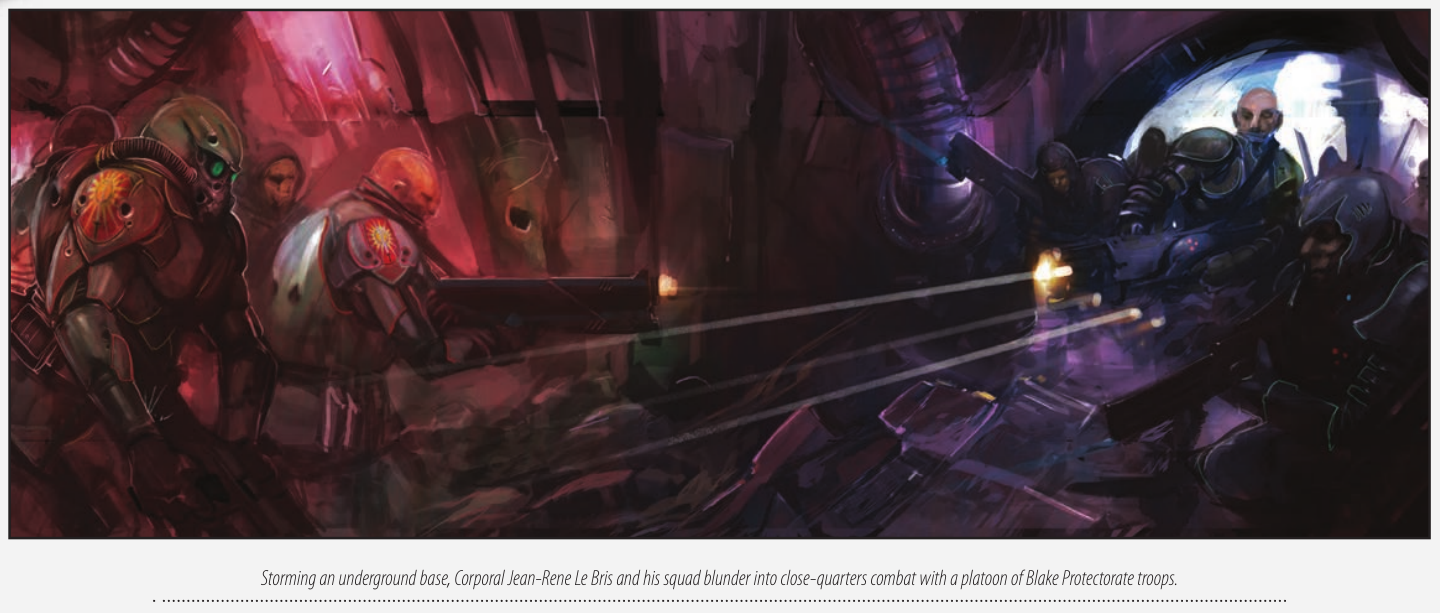
One-eyed guy in the background to the left is unfazed by the firefight going on.
These are essentially skirmish level rules for BattleTech, allowing you to quickly convert your AToW MechWarrior into his proper wargame version, and giving you the choice of using either the AToW or normal BattleTech action resolution (even with a table to convert normal BattleTech pilot damage into AToW terms). The former is more in favor of truyl elite characters, since normal BattleTech doesn't support characters with a better Skill Level than 8 (which equals a TN of 0 in BattleTech).
The biggest differences from normal BattleTech is the scale, with a single round being equal to half a normal BattleTech round. This adds some nice granularity to say a 'Mech duel, as almost all of their weapons now have a cooldown of 1 round, normal movement is split over two rounds, and jump jets have you be airborne for a bit.
This is also the smallest scale of BattleTech wargaming where infantry squads are split into individual soldiers, though you still get the option to have everyone fire as a single entity to speed things up.
Since this is a much smaller and personal scale, the classic 30-meter hexes of BattleTech aren't used. It's either proper tabletop or a consistent hex size. The book recommends 5 meters per hex, but that doesn't quite flow nicely with some area affects or vehicle sizes (since they're obviously taking up more than one hex under this scale). 1-meter hexes probably work the best.
If a PC finds himself in a normal BattleTech squad under fire, his EDG attribtue will determine how likely he is to be hit.
Getting hit with a 'Mech gun sucks big time. Sure, a PC on foot is hard to hit, but each and every vehicle weapon has a small AoE, and you can easily instagib even if you aren't directly hit. Even a lowly Small Laser has a good chance of ending you if it hits anywhere near you.
Small anti-infantry weapons are more surviable, but they can be easier spammed (since they don't have a cooldown under this system) and can be swept over a wide arc, hitting multiple targets with ease.
Special Pilot Abilities
A rather popular little sub-system that can be used to customize MechWarrior pilots, and even found its way into the Alpha Strike rules. Some Abilities also work for other kinds of pilots.
Special Pilot Abilities (or SPA) are essentially Feats, divided into Gunnery and Piloting Abilities, of which a MechWarrior can have three each. There ar also Miscellaneous Abilities that can be put into either a Gunnery or Piloting slot.
Gunnery Abilities
- Blood Stalker: A favorite among Clanners, allowing them to concentrate fully on a single target (with the downside that other opponents have an easier time hitting you).
- Fist Fire: Punch a 'Mech and then shoot with an arm-mounted weapon. Awesome.
- Marksman: Let's one emulate a Targeting Computer, or enhance an existing one.
- Multi-Tasker: Makes it easier to hit multiple targets.
- Oblique Attacker: Weapon Specialization: Indirect Fire.
- Range Master: Pick any range band aside from Short, and swap its target modifier with the Short one.
- Sharpshooter: Causes an additional critical hit after an aimed shot.
- Sniper: Makes it easier to hit at long ranges.
- Weapon Specialist: A general specialization for your favorite type of 'Mech attack.
Piloting Abilities
- Dodge: Makes it harder to get punched by a fellow 'Mech.
- Hot Dog: You are specially good at avoiding nasty overheating effects.
- Heavy Lifter: You can manage to make your 'Mech lift more than what is ordinarily possible. Do the impossible.
- Jumping Jack: If you want to fight more like a Gundam, take this Ability to creately reduce your to-hit penalty from using Jump Jets.
- Maneuvering Ace: You can move sideways like a QuadMech, and QuadMechs can do it even easier now.
- Melee Master: You get an extra attack whenever you punch, kick or swing a weapon.
- Melee Specialist: Weapon Specialization for melee attacks, with both better accuracy and more damage.
- Natural Grace: You prance around like a jester, wich among other things helps in very rough terrain and makes it harder to fall.
- Speed Demon: If you forego any kind of attack on your turn, you can squeee out some extra speed out of your machine.
Miscellaneous Abilities
- Combat Intuition: You can wait to move after everyone else has moved, or interrupt anyone else's action.
- Demoralizer: You can make a target shit its 'Mech pants and make it avoid coming closer to you. Funnily also works if you are in a 25-ton scout 'Mech and your opponent is a 100-ton Atlas.
- Tactical Genius: The commander of a force can use his EDG to re-roll initiative, and his underlings can't lose contact with him.
The Fires of Hell
After spending a good while dodging Word of Blake patrols, the group has found an enemy camp. It looks for all intents and purposes like a bunch of crappy militia troops - if it weren't for the fact that their Light patrol 'Mech is from the Celestial Series, a group of WoB 'Mechs for all weight categories made exclusively for the Manei Domini (aka rad killer cyborgs), so there's definitely something fishy going on.
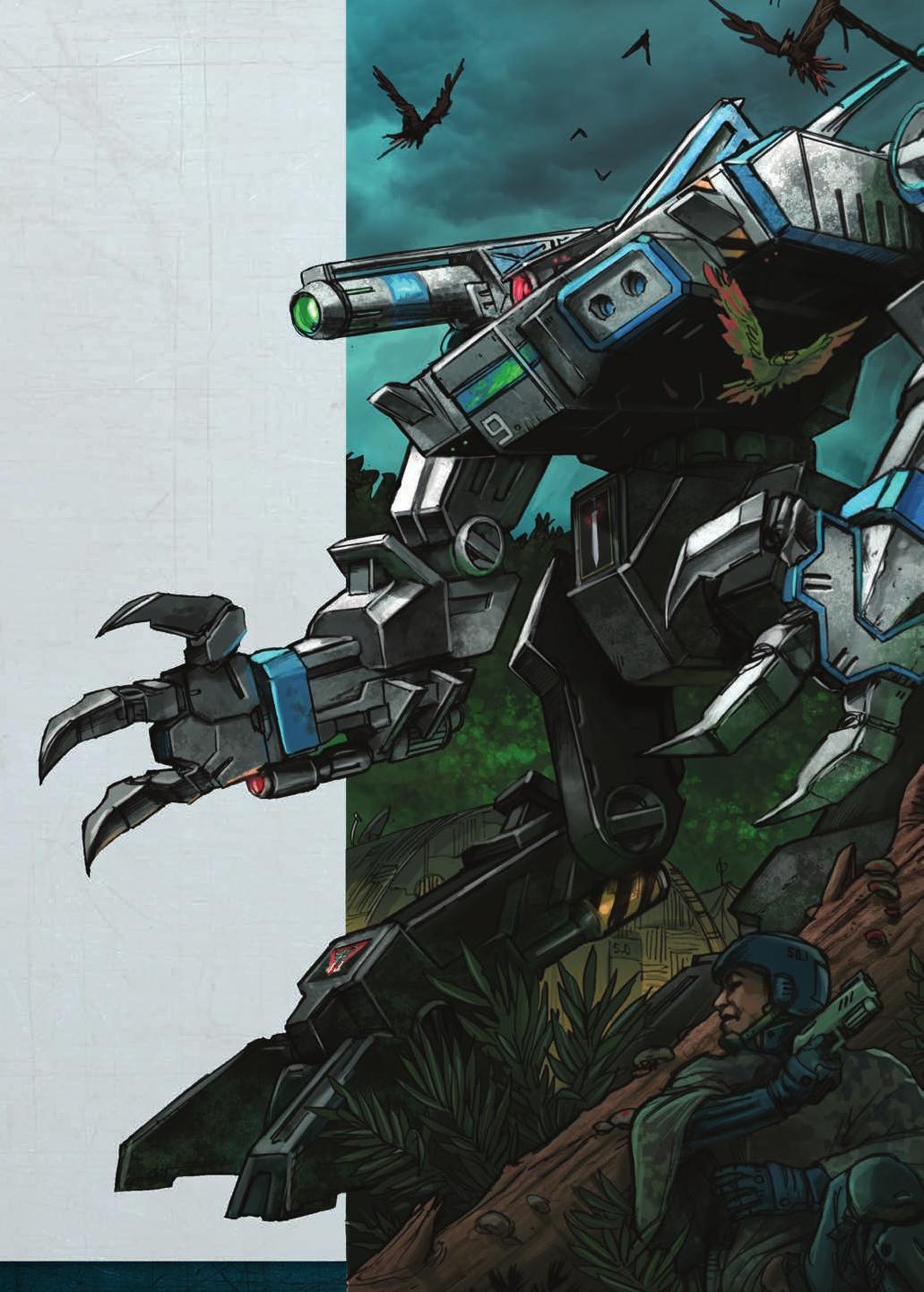
Metal Gear Blake
The group runs into a trap when they try to sneak into the place, resulting in the token 'Mech otaku Franz (who was left behind to take care of a wounded comrade) to do the obvious and hijack an unattended Griffin 'Mech standing around in the camp.
Despite being around twice as heavy as the patrolling 'Mech, Franz gets his ass kicked because the main reason he dropped out of 'Mech college was that he gets too excited to take care of things like radar or other forms of sensory data provided by the cockpit. Worst. Otaku. Ever.
Luckily for him, a stray shot of his manages to hit one of the giant trees surrounding the camp, which promptly crushes his cyborg opponent. Talk about dumb luck.
Infantry
The slowest and squishiest unit on the battlefield. An easy target in open terrain, they get nevertheless become very annoying when taking cover inside of buildings, making them perfect for urban warfare.
A typical infantry squad consists of 25 to 28 men depending on the faction. Their typical armament consists of ballistic (more damage) or energy weaponry (more range), with up to two support weapons for additional anti-infantry or -vehicle capabilities. Some squads are also trained for Anti-'Mech combat, making them badasses with balls of steel who climb on a 'Mech to deliver some juicy shaped charges.
Aside from the standard Foot Infantry, we have the Jump Infantry who uses jet packs or other forms of aerial locomotion to quickly cover gaps and high ground, making them even better for urban warfare and rough terrain.
Motorized Infantry makes use of motorcycles, buggies and other very small vehicles to get around faster. Mechanized Infantry instead uses sturdier jeeps and other vehicles that allow for multiple passangers, but are just too small to be considered worth tracking as actual vehicles under normal BattleTech scale. They have naturally more trouble fitting into buildings.
A funny thing about BattleTech infantry is the ludicrous variety of melee and archaic weapons you can equip a squad with. You know, just in case you want to fight big stompy robots with spearmen, Napoleonic soldiers, or biker gangs with nunchucks. You can also field Draconis Combine honour guards, who are samurai with vibro-katana and historical armor made out of state-of-the-art alloys.
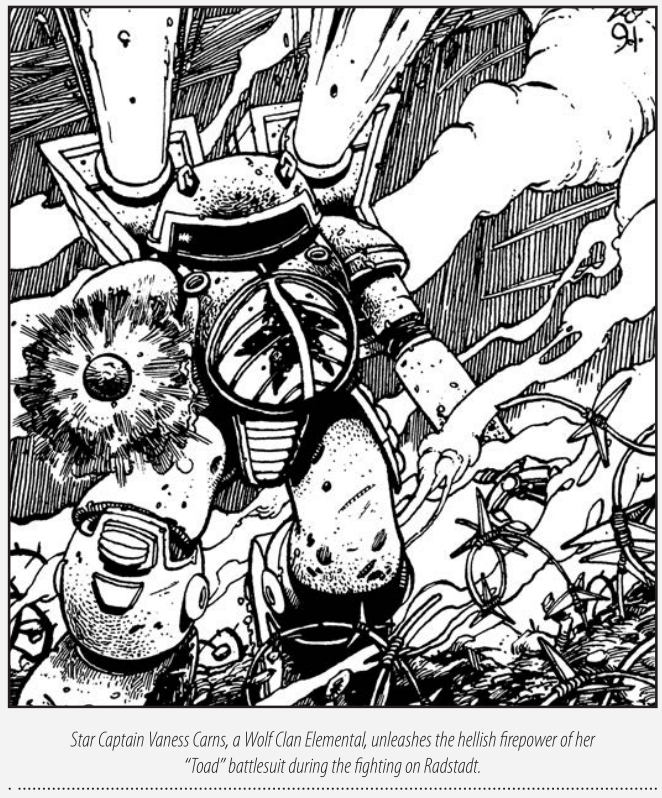
I love how dorky these Armors tend to look.
Battle Armor come in groups of 4 to 6 men, but they are more than capable to handle a squad of normal infantry.
Battle Armor originally started as failry normal-looking power armor from the Star League, but the Clanners just kept slapping more and more stuff onto them till they became juggernauts up to 2 tons in mass.
Aside from being able to shrug of smaller 'Mech weapons, Battle Armors are just bristling with infantry support weapons and even a few 'Mech-scale weapons (namely shoulder-mounted missiles). They often also have at least one powerful hydraulic claw to climb on a mech and smash through its cockpit.
For additional mobility, many come with jump jets or more specialized forms of movement, for say underwater operations.
The oddest kind of Battle Armore are probable the four-legged ones, who come with a mini-turret on the back. Thankfully, these aren't worn like normal Battle Armor, but rather function as enclosed bikes with legs instead of wheels.
Next Time: Environmental conditions and animals. You are likely to be eaten by a Branth.
Critters & Guns
Original SA post BattleTech - A Time of War
Critters & Guns
Man, I need to get my act together with this one...
Planetary Conditions
A boring but necessary list of how terrain, weather and other planetary conditions affect the player characters. They again work just like in the BattleTech wargame (with some adjustments made to accomodate the smaller scale of the combat participants), so know that fighting on magma crust is bad while getting as many trees between you and the guy firing at you is good.
Creatures
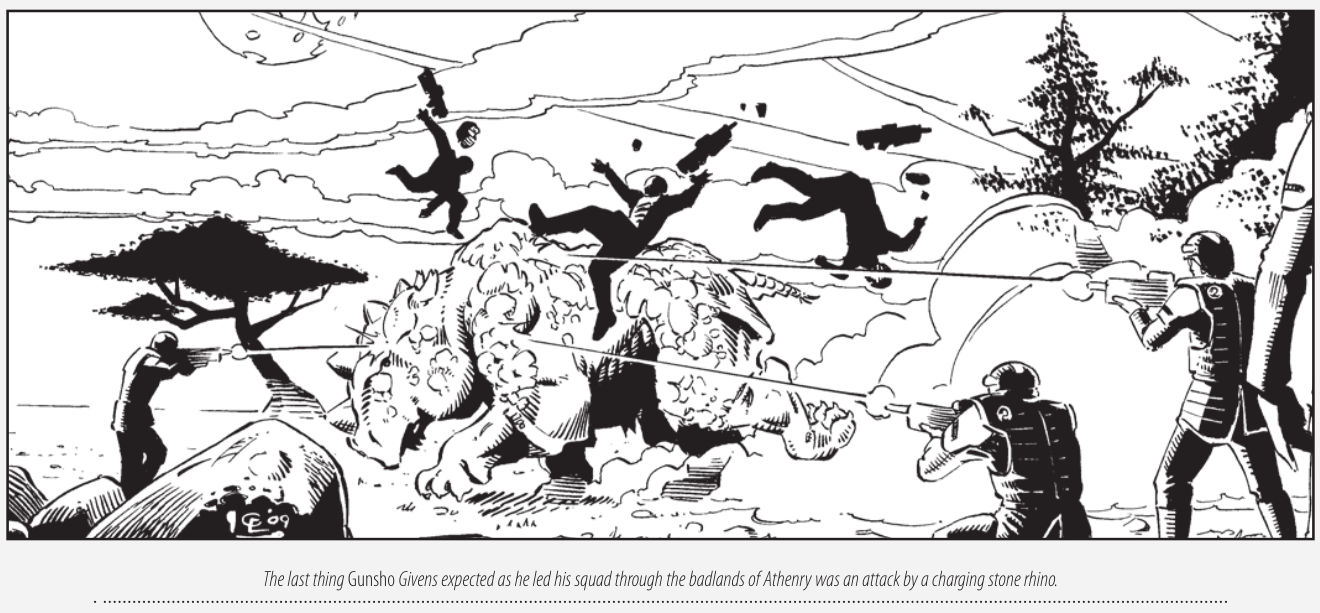
Sir not appearing in this little bestiary. Normal rhinos do though, so I guess you can just beef up that.
As mentioned way earlier, actual intelligent aliens aren't really a thing in BattleTech (aside form some tool-using primates and primitive bird people from that one novel everyone has erased out of their head canon). As such, alien life primarily takes form as more or less exotic animals and plants.
Creatures are build roughly like normal characters, except they don't have a Charisma score and only three Skills to pick from: Perception, Tracking, and the awesomely-named AniMelee. The latter is used for all natural attacks (including a special charge attack known as a Ram Attack that adds lots of extra damage depending on the distance covered) and kinda cheesy, with its base Target Number of 5 (in a 2d6 + modifiers game). Seeing how the TN for human combat skills is a 8, this not only gives them a juicy advantage right out of the gate, but seeing how hitting your TN gives you a bonus (most importantly a counter-attack) even if your opponent has the better margin. All in all, it is very difficult to engage with an animal in melee combat without getting hit.
If that wasn't bad enough, the example combat gives creatures a point-blank bonus, which isn't actually a thing for melee attacks.
Thankfully, all example creatures presented in the book have terrible natural armor against ranged attacks, and they are easier to knock out.
The list of example creatures includes a lot of mundane critters (also rats and orcas, in case you want to shoot those). Much more interesting is the list of alien critters (most of which sadly don't come with a picture):
- Alcor Bush Ape: The tool-using primates mentioned above. They cause general mischief and are the bane of the settlers of Alcor.
- Branth: A friggin' dragon, able to spew forth poison.
- Coventry Kangaroo: A genetically modified version of a normal kangaroo, now used as a mount.
- Godan: Sounds like a kaiju, but is just a dog-sized lizard who hunts in packs.
- Hipposaur: A gigantic six-legged thing with a hippo-like head and weighing almost 36 tons. Very docile and easily domesticated, it occasionally sees use on the battlefield. It can carry infantry squads and the occasional support weapon, and it has enough mass to knock down 'Mechs. If they have enough space to charge, they will turn you into fine red mist if you stand in their way. A full charge even deals more damage than a friggin' AC/20.
- Nolan: When not busy making critically-acclaimed movies, Nolans spend their time as poisonous, demon-looking predators terrorizing the planet of Engadine. The human population has an annual hunt going on to get rid of the Nolans, but their strength and intellect has kept them alive and well so far.
- Odessan Raxx: Big, six-legged and horned lizards who a favored as a camel-alternative in desert-like environments thanks to their bigger stature and calmer temper.
- Ovan Sylack: A monster frog that is extremely territorial. Tends to surprise humans with a sudden attack as it spends most of the day chilling out and living off the nutrients gained by the chlorophylic bacteria on its back.
- Steel Viper: A Clan totem animal. Unsurprisingly a big snake, with nasty venom to boot.
- Syramon Thunderbird: Doesn't have anything to do with thunder or lightning, and can't even fly. What it can do is be trained as a guard bird. I can only assume they look like very vicious ostriches. Or maybe monster kiwis.
- Tabinranth: Essentially a big feline, except docile. Kinda like a house cat big enough to use as a mount.
- Tariq: Lizard ostrich mount thingies, and another camel-alternative.
- "T-Rex II": Officially known as the Megalosaurus Tyrranus, but everyone calls it "T-Rex II" because it just so happens to look like a friggin' T-Rex.
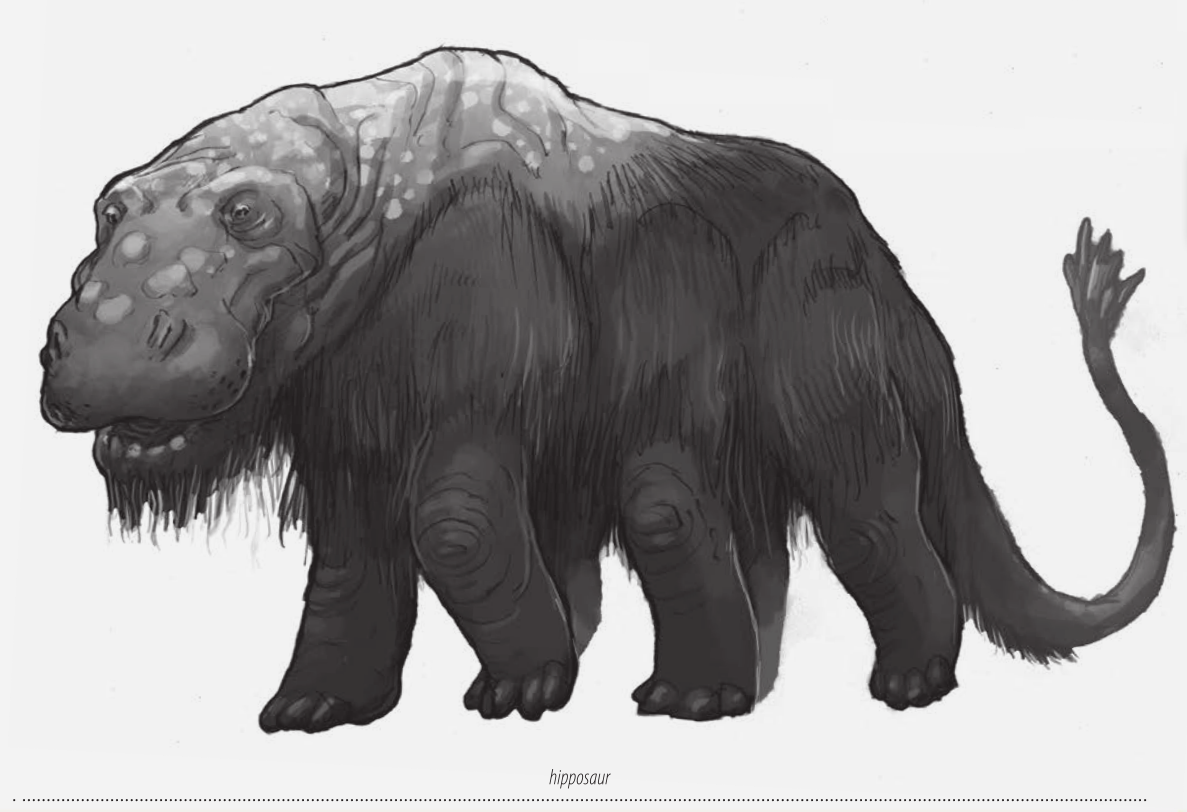
Hipposaur will end you.
Diseases
This section is thankfully pretty short, and gives you random disease tables instead of listing off some made-up stuff. The book is also helpful to inform us that you should only ever have a PC catch a disease if it's part of the adventure.
Equipment
Everyone's favorite section: lists and lists of all kinds of shiny toys for PCs to get their hands on.
BattleTech is a big fan of letter codes when it comes to equipment, mostly using the letters A through F. Each item has a Tech Level (A for primitive stuff, F for super advanced stuff only the Clans were able to produce initially), a Legality rating (from unrestricted to top secret) and Availability (very common to unique). The latter rating comes as a trio of letters for the general eras of BattleTech (Star League, Succession Wars, Clan Invasion), with equipment that didn't exist during an era getting a X.
Some pieces of equipment are closely tied to a specific faction, and they feature a lower Availability everywhere else as a result.
The currency of choice in the BattleTech universe is the C-bill, but there's a table with exchange rates for 14 different other currencies if you're into that kind of stuff.
Weapons
Melee and Archaic Weapons
I've mentioned earlier how BattleTech lets you equip your infantry squads with all kinds of archaic weapons. Naturally, the selection for PCs is a bit big for a futuristic setting.
Unfortunately for all D&D grogs, BattleTech doesn't care much about individual types of polearms. What it does care about is Japanese weapons (except the naginata because that's a polearm). Not only do you get all your favorite types of Japanese swords (even a friggin' Bokken aka a sword-shaped stick), but you get two different Japanese bows, which are essentially just a short- and a longbow who sacrifice some range for more damage.
And in case you're curious: yes, the Japanese swords are better than Western swords because everyone but the clumsy No-Dachi get an Attack Roll bonus. They are a lot more expensive as a result, though.
The book also really, really hates axes, which is why get an Attack Roll penalty. They don't even deal extra damage compared to swords.
Modern melee weapons include various kinds of stun weapons, monowire and your daily dose of vibro-weapons. The Vibrokatana rules supreme of course. They all require energy to work at full capacity, though.
An interesting little weapon is the Medusa Neural Whip. Doesn't have much in the way of armor penetration, but you can add extra power for improved damage.
Small Arms
The big divide here is between ballistic and energy weapons. Ballistic weapons are a lot cheaper, tend to have more burst-fire weapons, and offer a nice selection of alternative ammo types. Energy weapons on the other hand have a much larger range, better armor penetration (not to mention that more primitive types of armor are essentially useless against energy attacks), and they draw their energy from the universal Power Packs. They're very nice for extended field trips since you can just keep shooting as long as you can find some way to recharge those packs, be it some small solar module or the fusion reactor of your 'Mech.
The list of guns is a bit odd in that it features both generic weapons as well as specific models, with the latter often being faction-exclusive. Having such a wide variety of different variations of the same type of gun (the generic Auto-Pistol alone has 6 different named variants) of course means the weapon list as a slight case of "the best gun", with say the Lyrans and the Free Worlds League having their own kind of Auto-Pistol that is just straight up better than the generic one, and not even all that much more expensive.
There's nothing much too say about ballistic weapons, as they just feature different models of pistols and rifles. Laser are similar aside from the pulse lasers (the only ones with burst-fire) and blazers (binary lasers, aka double-barrelled lasers).
Personal-scale Gauss weapons hurt a lot, even come in burst-fire versions and can have a pretty high range. Aside from their high price, they also combine the worst of both ballistic and energy weapons in that they need both ammo and energy to function.
Flechette weapons get their own list, featuring needler guns and shotguns. For Zero-G operations, you can get yourself some gyrojet weapons. Other assorted weapons include a dart gun, a 40k-like flamer pistol, and the nasty Radium Sniper rifle which lets you poison people from over 1 kilometer away o_O
A lot less lethal is the Buccaneer Gel Gun, which shoots gel rounds to knock down opponents during boarding actions, and the Ceres Arms Crowdbuster aka the Sonic Boom Gun.
Support Weapons
The ballistic ones come in their usual variety of machine guns and launchers for various kinds of exploding goodness. The energ ones of course feature various oversized lasers and pulse lasers. They also offer flamers and the first man-portable particle cannons and plasma rifles, which can easily intagig you. Heavy gauss weapons are also a thing.
Explosives
Your various assortments of grenades, mines and demolition charges. Of particular interest are the Vibrabomb mines straight from the wargame, which can be set to respond to a certain tonnage range. Perfect for using your Light 'Mechs to lure in some heavier enemies.
Ordnance
For your launcher weapon. The list itself is a bit boring to read as each type of ordnance is just named "Class [A to E]". They come in quite a fun variety, allowing you to flashbang opponents, set them on fire, or just spread mines all over the place.
Specialty Ammuniton
Some nice goodies for ballistic weapons. Change your damage type with explosive rounds, change your effectiveness against armored or soft targets, set opponents on fire, get some subsonic rounds for sniper duty, or tinker with your weapon's ability to shoot through walls and such depending on whether or not that would be a good thing for you or not.
Gyrojet weapons can also get guided ammo, which offers a nifty attack bonus.
If you want to make sure that a fleeing enemy won't escape you, you can get some radioactive rounds. They're not radioactive enough to harm someone (beyond the normal harm a bullet does, of course), but they do allow you to track them.
Weapon Accessories
Customizing your guns is always fun in these modern or futuristic games, and AToW has a nice selection. Various sights and scopes, stabiliziers, silencers... heck, you can even modify your gun to shoot around corners.
Holsters are also featured here (a bit overkill to have to track those), and if you are for some reason really into bows, you can dek them out with scopes, too.
More specialized accessories include Guided Rifle Modules (necessary for air-burst and those rad guided gyrojet ammo), a Cloaking Device (which is actually a stealth suit you wear that shields your weapons from sensors), and the Radioactive Tracker Scanner to keep track of people you tagged with your radioactive ammo.
Personal Protective Equipment
The different armor types here come in different variations depending on what hit location you want to have covered. Jackets, suits and vests cover at least the torso and maybe also the arms and legs depending on the exact type. If you're legs aren't covered, you can opt for pants or "Shorts/Skirts/Kilt", which sounds pretty amusing. The latter option is only good if you want to safe on mass though, as your flak kilts and ablative skirts are both more expensive than pants, and they offer slightly reduced protection.
The armor types include Flak (good for ballistic, okay against explosives, crap at everything else), Ablativ€ (the same for energy and melee), and the Ablative/Flak combination which takes the best protection of either of its specialized versions and reduces it by one. Flak or Ablative can beat it in their respective fields, but it's probably better to stick with Ablative/Flak just so you are not totally screwed if say the enemy turns out to be carrying lasers instead of assault rifles.
More than twice as expensive and heavy is the Ballistic Plate Armor, using modern polymers. It doesn't make you immune against pistols, but it will noticably reduce incoming damage.
Neo-Chain Armor is just weird. Oldschool chainmail made out of modern ceramic-metal composites. It's pretty much a worse Ablative/Armor, and probably only exists because of the Draconis Combine's samurai honor guard (because yes, that's literally what they're wearing to go along with their vibrokatanas).
Myomers are similar to the Ballistic Plate, with a heavier focus on ballistic and explosive damage. They do require energy to function at full capacity, though.
Concealed Armor is a modifier for all armor types up to Ballistic Flak. More expensive and with less protection, but they are naturally harder to spot and lighter.
Combat Armor Accessories
This is oddly where you find helmets, offering (of course) protection against head shots and also against flashbangs. They come in Flak, Ablative and Ablative/Flak. The Standard Combat Helmet offers more protection, but is bulky enough to penalize your Perception. The Advanced Combat Helmet offers more protection, isn't nearly as bulky, and it makes you almost immune against flashbangs. Also includes comm equipment.
Also listed here are combat gloves to protect your hands, boots to protect your feet, and shields that essentially act as portable cover.
If you're the heavy weapon guy of the team (or are just too wimpy to carry enough guns), you might want to check out the Load-Bearing Equipment, which boosts your effective carrying capacity with the help of pouches and holsters.
Gripper Gear grants bonuses to climb rolls. They include modified boots and gloves that offer a better grip, and a Grapple Rod if you want to play Batman.
Standard Armor Kits
And it's armor time again. The previously mentioned armor types are just your generic types of armor for your average Inner Sphere citizen. Armor Kits are specific sets of armor used by the various militaries of the Clans and Houses. Each piece generally combines various types of generic armor, and all helmets offer at least comm gear.
There are sadly no pictures or descriptions on how these kits actually look like (which just makes me nostalgic for Heavy Gear), but they all seem to be making use of Ablative/Flak and Ballistic Plate, seeing how their protection is generally between those two types.
Clan armor is of course the best there is (beating Ballistic Plate anywhere but explosive damage), followed closely by the Magistracy of Canopus and the Marian Hegemony.
Also among these armor kits is your standard set for MechWarriors (with regular Inner Sphere armor sporting this fun vest + shorts combo, while elite and Clan MechWarrior get a more animeish suit). AeroSpace pilots always come with an animeish suit to improve their survival chances should they find themselves getting blown out of their cockpit.
For Zero-G combat, you can either get yourself a combat space suit or a heavier marine combat suit. There is also the Tanker's Smock for vehicle pilots, which replaces the soldier's normal torso armor for incorporated cooling systems.
Exotic Armor
Why not. If you watn to run around like a samurai or knight, go for it. You can even fight the Word of Blake in Kendo practice armor.
Hostile Environment Gear
Your various masks and suits to survive in all kinds of situations. The funniest thing is probably that the list includes sunglasses. You're not only wearing them to look cool, but also to give you a slight bonus against flashbangs.
Stealth Gear
Sneaky suits in various kinds of sophistication, from a simple camo gear to an energy-powered Sneak Suit. Each of them offers different protection against ECM, Infrared and visual sensors.
Non-Combat Attire
Your typical clothes. Goes a little bit overkill in that it includes swimear, underwear, socks and hats.
Electronics
Man, there's a crapton of stuff here. If you want to find a specific way to sense, record, surveil or talk to someone, this section has got you covered.
The various Power Packs also come in a staggering variatey with different weights and capacities, and there are also different kinds of rechargers. The weakest, but probably funniest, is the Kinetic Recharger, aka a hand crank.
If you want to be a spy, hacker or thief, there's also various espionage gear, be it a simple lock pick set or forgery kits.
Miscellaneous Gear
Since this is one of those games where armor can get damaged over time, you probably also have to get some repair kits sooner or later. Characters can also be patched up, and there is of course your usual assortment of wilderness adventure gear.
Prosthetics
Prosthetics in thse kinds of games usually come as simple replacements for lost limbs that are at least as good as the old thing. AToW covers the lower end of the spectrum. Your peg legs, glass eyes or primitive hand replacements that are either purely cosmetic or merely reduce the penalty for missing a limb.
Prosthetics come in several ranked Types that counteract the respective Lost Limb Trait. Type 4 and 5 Prosthetics are generally enough to completely negate any penalty from a missing hand/foot and arm/leg, respectively. These even come with a little bonus (namely increased strength and armor penetration to unarmed attacks).
Type 6 prosthetics are Clan-exclusive cloned replacement parts, which completely remove the Lost Limb Trait. Though even Clan MechWarriors don't make use of them all that often as the whole procedure takes longer than a simpler proshetic.
If you just want to look pretty, you can also get yourself some cosmetic modifications.
A bit more far out there and expensive (up to 1.5 million c-bills) are Elective Myomer Implants that slightly boost your physical abilities. More Strength? Check. Better punches? Check. Better reflexes? Also check.
The most expensive of the all is the Enhanced Imaging Neural Implant. Required for ProtoMech pilots, and usable by just about anyone else with the right cockpit modification, this implant offers a deeper integration with your vehicle of choice, granting you bonuses to piloting, shooting and sensors at the cost of a higher possibility for feedback damage whenever your ride's internal structure takes damage.
Fore really crazy stuff like additional limbs or subdermal armor, you sadly have to go to the supplement.
Drugs and Poisons
A lot of these don't deal damage per se (some even offer a slight bonus), but can result in nasty addictions. You gotta lova any system that not only differentiates between different intensities of alcohol (Clanners apparently have the hardest booze), but also makes caffeine addiction a possibility.
Also here are rules to make up your own drugs on the fly.
Personal Vehicles
Various kinds of vehicles (in both the wheel and hover variety), planes and boats. Most of this is civilian-only stuff, or jeeps and other vehicles that could be used by mechanized infantry.
None of these vehicles make use of an expensive fusion reactor and make use of anything from alcohol over hydrogen to batteries. Also included is coal. There's not a single vehicle on the list that actually uses a friggin' steam engine, but BattleTech's vehicle creation rules insist on being able to make steam-powered vehicles for some reason.
The Fires of Hell
Oh boy. After almost getting TPK'd and only surviving thanks to the team's 'Mech otaku and his massive luck, the group spends what must be weeks in the wilderness, avoiding Word of lake patrols and almost getting eaten by space panthers.
They finally come across civilization again in a suspicious looking outpost. Storming the place was almost a bit too easy, but then they ran into what must be the entrance of a top secret WoB complex. which in turn resulst in another almost-TPK when a couple rad killer cyborgs show up. They even result in a few casulties, including the team's brick shithouse getting his arms ripped off. Ouch.
Barely surviving the encounter, the rest of the team finds out the complex is for the planetary defense system, which has just started to track the Lyran invasion force headed towards them. A bit random tension, but at least they manage to more or less save the day.
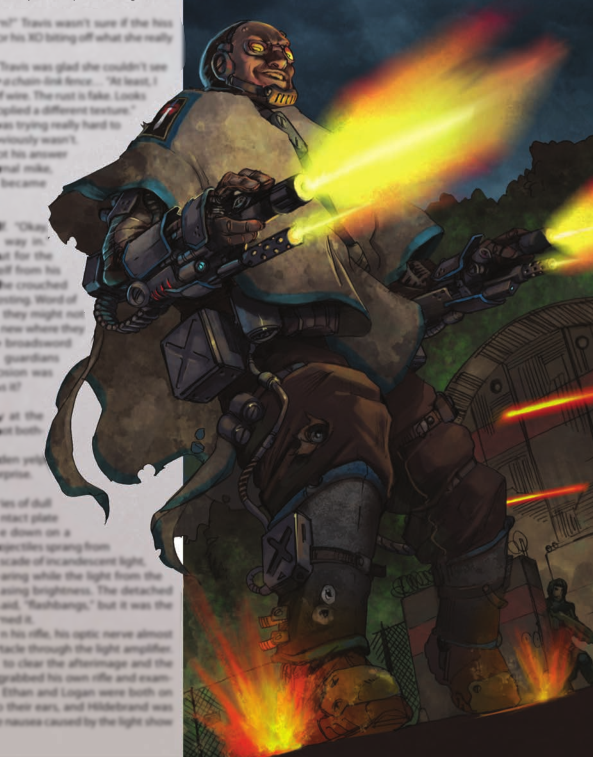
Looks like someone's having a blast.
Your BattleTech infodump of the Day: Combat Vehicles
Combat Vehicles include all your tanks, helicopters, hovercraft and other assorted rides to go along with your 'Mechs and infantry.
Combat Vehicles are handled in a more ismplified manner compared to 'Mechs and AeroSpace Fighters. They don't track heat (just slap on enough Heat Sinks during construction and you never have to worry about heat), and the exact location of your weapons and ammo is not all that important aside from turret weapons.
Combat Vehicles have the advantage of being not as tall as 'Mechs, and they have fewer hit locations, meaning each location is better armored. Their big disadvantage is their high chance of suffering motive system damage, rendering them immobile at best and pretty much destroyed at worst. A helicopter is pretty much toast if you hit its rotors, and BattleTech has strangely detailed rules to determine just how much damage you take from crashing (which is usually enough to destroy the vehicle anyways). They are essentially nerfed on purpose, what with this being a 'Mech game and all. Still, if you run into some 100-ton tank bristling with Gauss Rifles or AC/20's, you better watch out anyways.
Thankfully, there are optional rules in place to dial down the motive system hits, and you can even drift like a pro. Also those turrest with their 360° firing arc is nice, though they have a tendency to get damaged, fixing them in place.
Combat Vehicles are separated into various motive types, which sets their maximum tonnage and restricted terrain:
- Hover vehicles can go anyways except woods, and only go up to 50 tons.
- Naval vehicles are separated into Displacement Hull (aka boats), Hydrofoil and Submarine. All but Hydrofoil can go up to a whooping 300 tons, with Hydrofoils going up to 100.
- Tracked vehicles aka tanks also go up to 100 tons like 'Mechs, and are only really stopped by deep waters and dense woods.
- VTOL are the lightest at a maximum of 30 tons, but can go just about anywhere. Most VTOLs in this setting use rotors, and pretty much all of them look like normal helicopters.
- Wheeled only go up to 80 tons and are stopped by pretty much anything that is not flat terrain, essentially restricting them to urban warfare or artillery.
- WiGE aka Wing-in-Ground Effect go up to 80 tons and are airplanes that generate additional uplift by flying close to the surface. They're essentially faster VTOLs that can't just hover in place.
Now if you're wondering "300 tons sounds a bit light for a battleship", that's because naval Combat Vehicles are essentially patrol boats. Big dreadnoughts, aircraft carriers or submarines with ICBMs are too restrictive in the futuristic warfare of BattleTech, where invasion forces hop from planet to planet to duke it out with fighters and 'Mechs. They are only really seen on planets with lots of ocean, and even then they play more of a defensive role. But that's a topic for next time...
Next Time: Character Advancement. It's slow. Very, very slow. Like my release schedule.
Character Advancement & Gamemastering
Original SA post BattleTech - A Time of War
Character Advancement & Gamemastering
Now for the bits of what happens after an adventure, and how all of this is supposed to be planned and run.
Character Advancement
AToW splits XP rewards in group and individual awards. Group awars are based on their success on a Mission (aka adventure) or campaign (aka a series of related adventure, of which there can be several going on at once). The exact rewards are based on how successfull they were and how hard the whole procedure was. Simple an moderate Missions reward XP in the lower single digits, while 10 or even 20 XP only really happen if the group completes a Moderate or Difficult Campaign.
Individual rewards are based on character development and general good roleplaying, and are on part with Mission rewards.
Seeing how an Attribute or Trait point is worth 100 XP, and even learning a Skill at level 0 costs 20 (and quickly gets more expensive afterwards), characters in this game aren't really advancing all that fast. The book recommends that more powerful characters just start out with more XP during character creation, but I guess you can always hand out bigger rewards.
Aging
Simlar to D&D, AToW comes with an aging table to determine the effects of old age on your Attribtues, accomplished by adding or removing XP from your Attributes.
The first two relevant ages are 25 and 31 years and offer bonus to almost every stat. Then things quickly become worse and worse every 10 years after.
Starting with 61 years, characters also gain negative Traits they can only suppress until the next age category. It starts off with Slow Learner (aka Skills get more expensive) and is quickly followed by Glass Jaw (aka you better not come anywhere near a fight).
Clanners get an extra set of negative Traits (and much sooner at that, starting with 31 years) for their Reputation, since Clanners have a thing against people over 30, unless they have already made a name for themselves.
There are no rules for when one actually dies of old age. The table just stops at 101 years, but by that point most of your Attributes are probably level 3 at best, and there's a good chance one of your Attributes goes below 1 even sooner, which depending on the ATtribute either kills or cripples you.
Training & Downtime
Training is useful. Not only is it required to learn Advanced Skills, but it generally makes the learning or improving the learned Skills cheaper. Naturally, the teacher must be better at the Skill than the student.
Downtime is a way to get a bit of XP offscreen if the group is skipping several weeks or monhts of in-game time, after let's say the last Mission left a number of them in dire need of medical attention. The XP are based on the character's INT, and he can gain additional ones if they can make use of one of their Career Skills. It's not much, but better than nothing.
Training can also be done during Downtime, which effectively doubles the XP earned with the restriction that all of them go into the learned Skill's pool.
Wealth & Property
This section offers a base salary table (with modifiers depending on your average level in the relevant skills). MechWarriors and their space-counterpart the AeorSpace Pilot earn the most with 18k C-Bills per year, while a regular grunt soldier has to contempt with half of that. There's also a bonus table to eyeball extra cash after completing Mission and Campaigns, which is pretty handy.
The salary table itself is heavily focused on military professions, but also includes more civilian spaceship crewmand, technicians and doctors. Stuff like journalists, detectives or even policemen are absent.
With monthly income comes monthly expenses, and a table for that lists taxes (or rather a tax, the book thankfully doesn't go insane with different taxes for different factions or similar stuff), housings and other services.
NPCs and Random Encounters
NPC creation is surprisingly smooth: You pick one of the four templates and pick the relevant Attribute, Trait and Skill levels. The levels themselves are based on a comparable PC, having either less or more depending on the template.
The templates themselves are Thug (cannon fodder that is roughly half as good as a PC), Soldier (who are closest to the PCs in power), Savant (cripplingly overspecialized NPCs who serve as living MacGuffins; your diplomats and scientists) and Boss (who are just stronger than a PC in any way).
There's also a random encounter table that's just kinda there, offering plot nuggets to build a Mission around or derails an existing Missions like in Maid RPG, like having a little round of 'Mech arena action disrupted by a surprise invasion.
Gamemastering
The general suggestions start of with the book being pretty open about the GM tinkering with the setting as much as he wants, like say making FTL travel faster, put more angsty teenagers into 'Mech cockpits, or ignore the whole Clan Invasion if you're a BattleDroids grog. Of course you should spend a few minutes thinking about the impact theses changes would bring.
What follows is fairly standard advise, with the GM being advised to be well prepared and fair, and to make sure that everyone has fun (John Wick would hate this game). Whether or not the group is into sandboxes or plot-focused campaign, AToW works with both.
Adventure Seeds
These are adventure ideas, all written in the same format: They list the recommended group size, type and skill level range, along with the general premise, several complications (which actually read more like how the adventure is intended to progress) and tips.
- The Chase: The PCs are hired to hunt down an assassin, with the scope of the adventure ranging from a single planet to several worlds. Naturally, the assassin will try to keep his pursuers busy, and the PCs' allies may not be as trustworthy as they appear...
- Civil War: A classic BattleTech tale: The PCs find them self in the beginning or middle of a civil war, whose scope can again range form a single planet to entire systems. Who will they join? What will they do with former friends on the other side? And what if they find out they've bet on the wrong horse all along?
- The Birthright: A noble is about to kick the bucket, and his friends and family are already starting to scheme against each other. Basically full-on Game of Thrones.
- The Package: The PCs are task to retrieve an unspecified "package". There will naturally be other parties interested in the package, which may or may not turn out to be a person, in case you want to play The Transporter with 'Mechs.
Your BattleTech infodump of the Day: Support Vehicles
Support Vehicles are a pretty big and varied category of vehicles, ranging from all kinds of civilian models to vehicles to millitary support vehicles like tankers, minelayers or artillery. Also satellites, though I'm not sure how often they pop up.
Though not meant for direct combat by default, you can beef them up to be comparable to real Combat Vehicles. In fact all military vehicles are built as Support Vehicles until certain technological breakthroughs during the Age of War.
Unlike Combat Vehicles, Support Vehicles allow you to build Airships, aka blimps. As they also cover support versions of the Conventional Fighter, they also let you get yourself some Fixed-Wing motive systems.
Unless built for combat engagements, Support Vehicles lack proper targeting systems (if they have weapons at all), and their armor is generally worse than a proper combat armor. They might have a comparable number of armor points, but they also tend to have a Barrier Rating that shows how much damage an opponent needs to deal before the attack just punches through the armor and causes structural damage.
Support Vehicles are also a lot more flexible in terms of tonnage. You can make them light enough to be a motorcycle, or a lot heavier than a Combat Vehicle equivalent (more specifically: they can be up to twice as heavy as a Combat Vehicle of the same motive type). So if you go through the extra hoops of building a combat Support Vehicle, you can make yourself a 200-ton tank. With a steam engine.
A somewhat annoying part of Support Vehicles is that they require a Tech Rating, which among other things determines how much stuff you can put into it and how well they are armored.
But wait, being twice as a heavy as a Combat Vehicle is still not enough for friggin' huge battleships. Fear not, for there are construction rules for Large Support Vehicles that are big enough to cover multiple hexes on the board.
Large Naval Support Vehicles can reach up to 100,000 tons, able to mount capital weapons that can fire into at targets in orbit. Large Airships are up to 1,000-ton behemoths. And you can built yourself modular Rail vehicles.
If you want to go even bigger, you can build a Mobile Structure. They are build more like buildings (aka they consists of multiple hex blocks with different heights that are damaged seperately) that just happen to be able to either move on the ground, in water or in the air. They can also get themselves some capital weapons, which are terribly inaccurate against normal vehicles, but do make some beautiful craters.
I sadly don't know about any official Mobile Structure designs (which has probably something to do with them tending to be noticably bigger than DropShips), but I hope there's some kind of flying fortress or gigantic monster tank right out of an Armored Core game somewhere in the Inner Sphere.
Next Time: More setting details - A Game of Space Thrones (I may have made that joke before).
Political and Military Power
Original SA post BattleTech - A Time of War
Political and Military Power
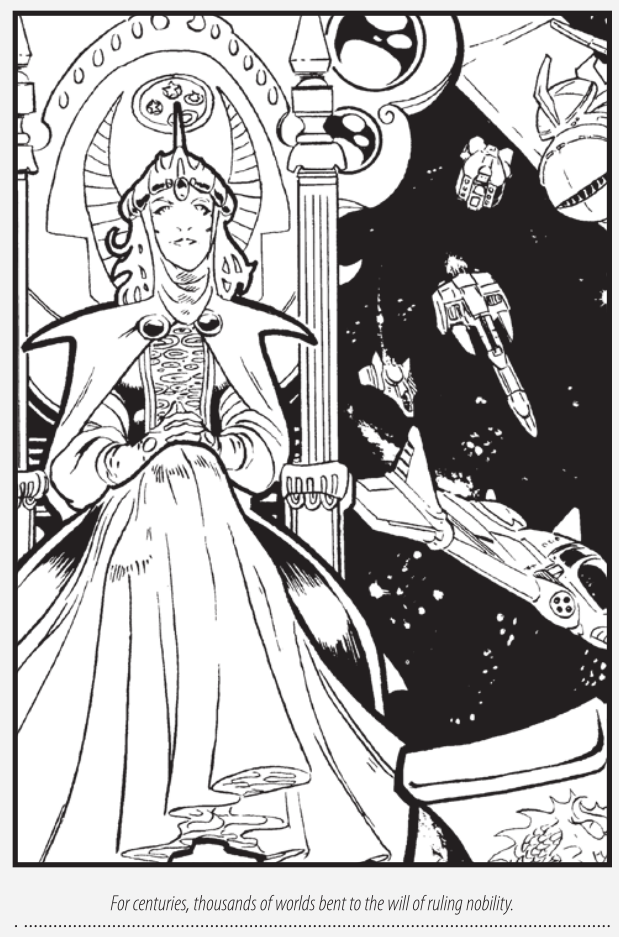
I think I've seen that chubby fighter in FreeSapce.
This chapter starts off with a helpful reminder to all potential John Wicks out there that if the players spend some of their limited resources for Traits like Rank, Title or Connections, it's a pretty dick move to constantly punish them for picking those Traits or fabricate events that deny them any utility out of them.
That being said, especially the Traits Rank and Title might not work out as planned for the PC within reasons. The population of a more lawless world might not care much about a Duke from some faraway planet (and this might in fact just attract criminals), and highly-decorated military officers might not find a warm welcome in the realms of a former enemy.
Now as we all know, as one rises in rank, one has to spend more and more time with paperwork and other boring stuff, leaving less time for adventuring. The book offers three helpful solutions for this:
The GM can introduce a soft cap on the PCs' political or military advancement, so that the game's scope never develops beyond a certain point. If the players are happy with MechWarrior adventures, they'll probably never want them to gain a Rank to would have them spend less time inside a 'Mech cockpit, though that's still an option if a player wants to retire his character or everyone agress to raise the cap.
Since the shenanigans between the Houses of the Inner Sphere lend themselves well to Game-of-Thrones-style campaigns, the GM might just take cues from the actual Game of Thrones RPG, giving players control over multiple characters with varying levels of power. So everyone could have some kind of noble or general for court intrigue adventures, while they also have more or less low-ranking grunts to carry out whatever missions the above general has cooked up for them.
Lastly, you can just combine AToW with regular BattleTech, specifically the later supplements that abstract and zoom out far enough to allow battles to unfold on a global and even interstallar scale. The players can then for example carry out a planetary invasion and them zoom back in all the way into their cockpits for the final confrontation.
Titles and Ranks explained
Here we have a big old collection of the various titles and ranks one can attain in the world of BattleTech. They do come with different names depending on the region, but here are the general names for now:
Knight Bachelor is the lowest and most numerous of titles. Granted to soldiers for their loyalty and service of the realm (or to rich guys depending on the region), this title doesn't really offer any benefits in and of itself, but not being at least a Knight Bachelor can make future advancements in the military very hard to pull off.
Knight Bannerets are Knights that have been invited into an actual Knightly Order. This comes with plenty of prestige and a readily-available network of connections and favors, but a Knight Banneret will also be expected to not live up to the Order's standards and might, and his closer ties to his realm makes settling in other parts of the Inner Sphere somewhat difficult.
Baronet is one of the highest honor for Knights and commoners, as it not only marks the holder as a hero awarded for his outstanding duty to the realm, but is also hereditary. Though this is somewhat of a double-edged sword (and good PC archetype), for the inheritors of this title will always be measured against their ancestor. As such, the title doesn't so much come with benefits as with expectations.
Baron is the lowest and most common hereditary rank. The title itself doesn't really come with any sort of power or leverage, but the holdings tied to it usually make up for it.
A Viscount on the other hand is a notable step up in that the title itself grants political power and influence.
Count/Countess is were things get serious. Like with a Baron, the title in and of itself is nice and all, but most Counts and Countesses happen to be influential politicians and/or owners of entire cities or corporations.
Marquis/Marquessa typically have power over entire continents or smaller worlds, though the exact level of influence and power can vary wildly from one Marquis to the next.
Duke/Duchess is the most powerful title PCs are typically allowed to have, granting power over one or more entire worlds.
A Grand Duke/Grand Duchess is most likely the most important type of NPC the players are ever going to see. Each of them oversees entire regions of their realm, and they answer directly to their sovereign.
The second most important person of any realm is probably either the Sovereign's Heir or his right hand, the Prime Minister.
Finally, we have the Sovereign or Head of State, or House Lord. Effectively the kings and queens of this feudal space setting, their power is absolute, and their appearance in any campaign should be kept rare and monumental.
Clan Social Rank
As Clans do things a bit differently than the Inner Sphere, they have their own brand of ranks and titles.
Generally, if you're not part of the Warrior Caste, you don't really have much to say. With exceptions like Clan Ghost Bear, the Warrior Caste doesn't really care much about its citizens and might just have them work in factories that look more like a prison or something from the 19th century, just because they hate their guts.
To enter the Warrior Caste, you generally have to be Trueborn, aka part of the Clan's super soldier program. A normally-born aka Freeborn can still qualify, but such an occurence is pretty rare, and you have to be quite some bad enough dude to impress a Trueborn.
Few members of the Warrior Caste are contempt with just being Trueborn. What really counts is being Bloodnamed. Being granted a Bloodname (aka a family name from the Clan's founding fathers) not only puts you in a long line of exceptional warriors, but also means that your genes will be used as part of the next generation of Trueborn.
But not all Bloodnames are created equally. Some are used by several different Clans, while others are exclusive to one Clan. Some are used by several different kinds of warrior, while others are exclusive to a specific Phenotype (like say a Bloodname only used by MechWarriors). And finally you have Bloodnames of immortalized badasses like Kerensky himself. Earning such a Bloodname puts enormous pressure on the Bloodnamed, as failing in battle disgraces the entire Bloodname.
Common Military Rank
A list of generic military ranks (the supplement has ones specific to each Inner Sphere realm). They include all your typical ranks like Lieutenant and Colonel and such. MechWarriors are generally equivalent to a Sergeant, and there's a handy list to compare military with social rank, with a Grand Duke being roughly similar to a General of the Army for example.
Clans have more unconventional ranks, with stuff like Star Commander or Galaxy Commander. The equivalent of a Inner Shpere House leader is the Khan. Even above that is the ilKhan, the Khan of Khans, th eone who coordinates all the Clans' actions.
Universal Aesthetics
Like any human-centric sci-fi setting with sandbox capabilities, worlds can vary wildly from the Earth standard, and especially inhabitants of the more isolated planets can develop a couple strange customs.
Also rather Traveller-esque is the variance in possible technology levels. Some worlds are industrial and technological juggernauts, while others have been hit hard by the Succession Wars and never really recovered from it. And since the Warrior Caste id a bit dickish, lower Clan castes can live under downright primitive conditions even compared to the Inner Sphere.
MechWarriors and their 'Mechs
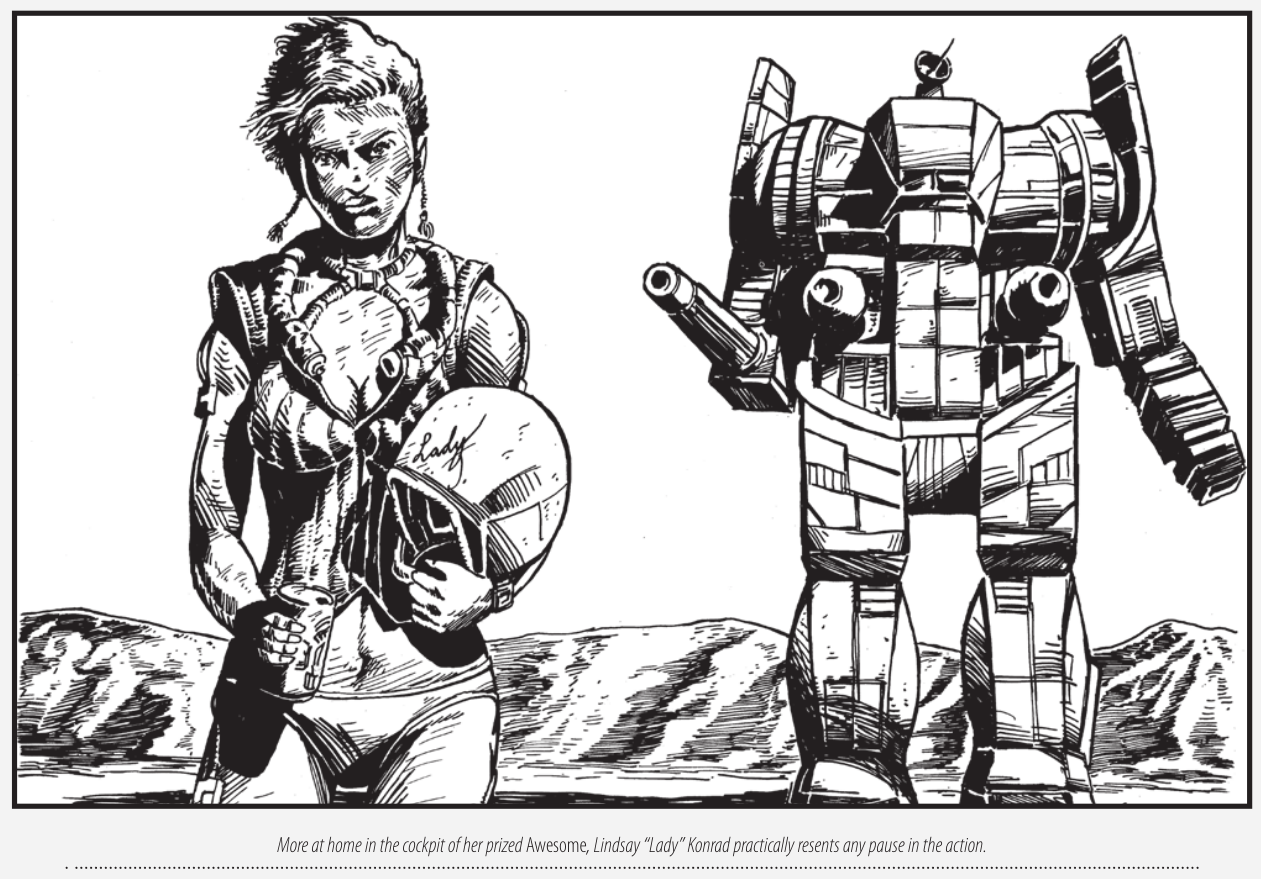
The live-action Gurren Lagann movie took a somewhat more lowtech approach.
Everyone loves big stompy robots. And while you don't have to be a MechWarrior in this game, the chances are pretty darn high. It's fine to solve every problem with several tons of walking death and destruction if everyone's aboard of it, but it offers a couple tips to get them out of their cockpit.
This is thankfully nothing along the line of "Make sure their 'Mechs break constantly" or "Ambush them everytime they're on foot" (which will just make them stay in cockpit even more), but just a general list of problems that can't be solved with a big stompy robot, or destinations that can't be reached by a big 'Mech.
Touring The Stars
Also the name of a series of mini-sourcebooks highlighting some of the planets of BattleTech. Naturally, this section is all about the different worlds and their societies the PCs might end up visiting.
Government Types
The Great Houses of the Inner Sphere rule over there realms in a feudal system, necessitated by the vast distances in space, even moreso in the early days when FTL communications weren't a thing. While the Free Worlds League under House Marik is officially democratic, the Mariks are no stranger to go full-on autocratic with edicts and such.
Individual worlds on the other hand can have all kinds of governments, be it a dictatorship, actual democracy or just plain anarchy. Most Houses are fine with this as long as the worlds stay loyal, and they tend to give their representatives feudal titles anyways.
Clans follow a more oligarchic approach, were the leaders of the various castes meet in councils. The Warrior Caste always has the last word, but they don't really care about civilian matters and tend to let those castes do their own thing unless they get a bit too full of themselves.
Law and Order
Naturally laws and punishments vary wildly between worlds, and while nearly all realms advocate fair and just trials, they are actually heavily biased towards whoever has the higher social status and/or influence.
Clans are really fond of punishing people by kicking them down the caste ladder, flogging them in public or sending them for a round of re-education. And if your one of those dirt farmers from a non-warrior caste, getting convicted is largely a matter of whether or not the judge feels particularly dickish today or if he likes you or not.
Warriors on the other hand can avoid their conviction with a Trial of Refusal, which is more or less a Game-of-Thrones-style trial by combat except the trial is made more or less difficult depending on the severity of the crime.
Police Forces
The police of the Inner Sphere is generally very professional and well-equipped (which sounds oddly noblebright if you ask me). Then Clans... well, not so much.
As already mentioned a couple times, the Warrior Caste doesn't like dealing with the other ones. This is why they assign their bottom tier warriors for police duty, which is basically a way of being demoted to a "half civilian". Naturally, the Clan police is not particularly motivated and prone to brutality.
Though like in several other aspects, the invading Clans mellowed out when they permanently settled in the Inner Sphere. Especially the concept of a police force that is well-equipped, respected and actually proud of their work was mindblowing to them. The Clan-occupied worlds really seem to lend themselves to buddy cop campaigns.
Language
English is the common tongue of the setting, but pretty much everyone knows at least one other language, and just about every faction as at least three commong languages spoken.
Clans mainly speak English with some Russian words thrown in like it's A Clockwork Orange in space. Unlike many in the Inner Sphere, Clanners have a distaste for abbreviations and other forms of colloquial language.
Education
Well, this has seen somewhat better days. Ever since he fall of the first Star League, most worlds have little to offer after primary school, and any sort of standardized education system has a tendency to focus more on indoctrination or making higher education only affordable to those of a higher social status. The Taurian Concordat has the closest thing to 21st century education, but nobody else managed to copy this format so far.
The Clans offer basic education for everyone and let the respective caste do the rest.
Work
Thanks to the above quality education most people of the Inner Sphere receive, apprenticeship is very common, and true to the feudal theme of the setting, it's pretty normal for a child to learn the same job as his father, probably even working in the same company.
Clans use tests to determine to which caste a child gets assigned, which are of course heavily biased to make it very hard for a Freeborn to qualify for the Warrior Caste. The Capellan Confederation is a bit similar, but it heavily encourages its citizens to work hard and eventually "level up" into a better caste.
Gender inequality isn't really an issue in the setting, especially if you're a Clanner because Clan society only cares about how much ass you can kick. The big exception are the Draconis Combine and Capellan Confederation, since those whacky Asians like to stick with traditional gender roles. Still, talented women can break the mold, as evidenced by this book's supplement featuring a picture of a female Combine MechWarrior inheriting her fathers 'Mech and katana.
Like our curent Earth, all but the most backwater worlds are advanced enough that only a tiny portion of the population has to work in agriculture or heavy industry, with most taking service-sector jobs. This is reversed for Clans as the Warrior Caste doesn't like service-sector jobs, or their civilians for that matter. Even if this means that their factory and such tend to be overstaffed like crazy (which probably gives rise to self-fulfilling "All non-warrior castes are lazy" stereotypes).
Entertainment
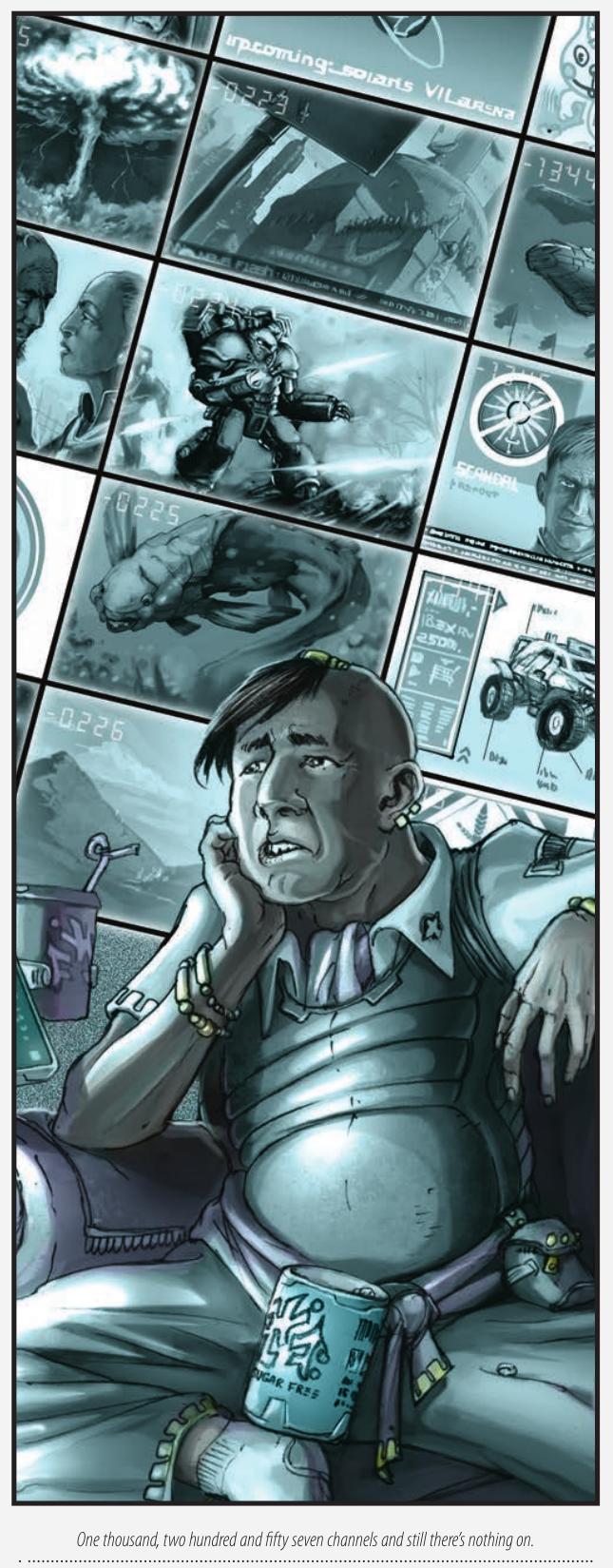
This is my hero.
There's nothing really all too different here, safe for the addition of zero gravity entertainment and the ever popular 'Mech gladiator world of Solaris VII.
Media and Communication
Sending messages over interstellar distances can take quite a while. Even the fastest networks can take days, and it only goes up from there. Planetary communication is a lot better, of course.
Thanks to the overall decline in technology, the above-mentioned crappy education, and ComStar playing 40 Techpriests for a good while (and because this is a sci-fi setting from the 80's), everyday technology and electronics can appear strangely primitive as opposed to our current situation. All your computer and phone equivalents aren't are more specialized, without the vast applications of a smartphone. Don't even think about finding a hand-sized device that can record videos, communicate with other devices and play Angry Birds. I think one of the books of the main BattleTech line basically described this situation as the Inner Sphere being basically in the 90's.
Religion
Not a lot has changed here. All the major religions are stil practiced, though some regions are a bit more restrictive than others (Space Japan doesn't take kindly to Christians and Jews, but they do have a sizable number people of Arabic descent).
There's a new branch of Roman Catholicism in the New Avalon Catholic Church, and there's the Unfinished Books Movement for those that just like to pick-and-choose from pretty much every religion.
A more unique religion is the One Star Faith, based on the belief that Kerensky and crew left to find a paradise. Naturally, this little belief has become somewhat irrelevant after Kerensky's descendants returned as conquerors.
And then there is the Word of Blake, which has turned ComStar into a weird cult before getting split off into their own faction of nutjobs. Hording old technology and deeming it unworthy for normies, these guys are pretty much 40k Techpriests with less skulls. They are also known as "toaster worshippers", which is a hilarious slur.
Travel
People in BattlTech generally use the same forms of transportation than we do. Since most planets in the Inner Sphere aren't nearly as populated as Earth, there are generally not many roads and other car-friendly infrastructures around, making trains and airships a lot more common.
There's of course interplanetary travel with DropShips and JumpShips, but their numbers are so low compared to the human population that pretty much only one in a million goes around planet-hopping.
Economics and Industries
It's time again for letter codes, this time ones that actually exist in-setting: The Universal Socio-Industrial Level Reference aka USILR uses a five-letter-code (the letters being the BattleTech standard of A through F) to catalogue planets and offer a quick summary of what to expect from any given world:
- Technological Sophistication: Essentially tells you how hard the world has been hit by the Succession Wars. It might still have the latest in technology, or it might look like 20th century Earth at best.
- Industrial Sophistication: Is it an industrial powerhouse, or is it more like Dirt Farmer World?
- Raw Material Dependence: How much does the population rely on imports, or does it produce enough to allow for exports?
- Industrial Output: Sort of a combination of the above two, going into how much industrial products the world can manufacture.
- Agricultural Dependence: The same as the above, but with food and other agriculture products.
Keep in mind that with the above shortage of JumpShips for everyone, even the biggest trading world only export a relative tiny amount of their products. Imagine if China or the USA only had a handful of container ships.
The USILR code can also be used to determine the type(s) of a world. Worlds with little Agricultural Dependence are often referred as Garden Worlds for their lush and abudant flora, while worlds living on the cutting-edge of technology like Earth itself are often called Advanced Worlds. Then there are BackWard Worlds, which is like a world full of Amish, except most didn't have a choice but to regress after the Star League crumbled.
Whistle Stop Tour
A short list of example worlds with their history and USILR codes.
El Dorado (Population 4.3 billion, Federated Suns)
Named for its richness in water and minerals, El Dorado has the all-around perfect score of A-A-A-A-A. It is also known as "Terra's prettier sister" for being very Earth-like with nicer scenery. Nothing is perfect, of course, and El Dorado does come with two drawbacks: Its gravity is 25% higher than Earth's, just high enough to deter some possible inhabitants. There is also a lot of volcanic and tectonic activity going on, but the population has long moved to safer regions.
One of the major reasons for El Dorado's excellent situation is that it was barely touched by the Succession Wars, with a nuke to the JumpShip yard being the only attack during this time. It was of course affected by interstellar trade taking a nosedive in the later Succession Wars, but the population got their act together and managed to become largely self-sufficient.
Arcturus (Population 1 billion, Lyran Alliance)
A fairly average world for the Inner Sphere, right down to having little natural resources left and not being self-sufficient as a result.
Arcturus used to be a pretty important world as it used to be the Lyran Alliance's capital, but its decline and population has gone downards ever since th end of the Star League.
Since the first two Succession Wars got very nuke-happy and a capital world makes for a great target, the inhabitants of Arcturus fled the cities out of fear and build more rural communities, leaving their metropolises to get either nuked into oblivion or slowly fall apart. Even the only industrial complex is mostly underground as a result.
Ovan (Population 5.2 billion, Capellan Confederation)
Another average-ish and very old world orbiting a red dwarf in a stable circular orbit. The original colonists created an artificual river around the equator, at which coast one can find the majority of the population.
Culturally, the citizens are ruled by a group of noble familie that got into power in the Second Succession War. These families do their best to get on the Capellan's good side so they look the other way at their shenanigans, which include extorting their citizens as both the government and the puppet master behind just about every criminal activity on the planet. As if citizens of an interplanetary communist police state couldn't have it any worse.
Annapolis (Population 3.4 billion, Draconis Combine)
Once a lush and rich world similar to El Dorado before crashing down very, very hard. Heavily financed and hyped by the Terran government during its beginnings, it was abandoned and left to rot after vicious local microbes adapted all too well to Terran crops and then Terran organisms in general, causing all sorts of medical problems for the population.
Thanks to its plentiful resources, the people that were left on the planet did manage to get through this crisis, even if they had to start from scratch on several occasion. And then the Succession Wars happened.
Nowadays, most citizens live as peasants working under 19th century levels of sophistication. Some people in remote locations have even regressed back to the tribal stage. The nobility on the other hand live a comfy live in an actual modern city, walled off to keep the dirty peasants out.
Solaris VII (Population 495 million, Lyran Alliance)
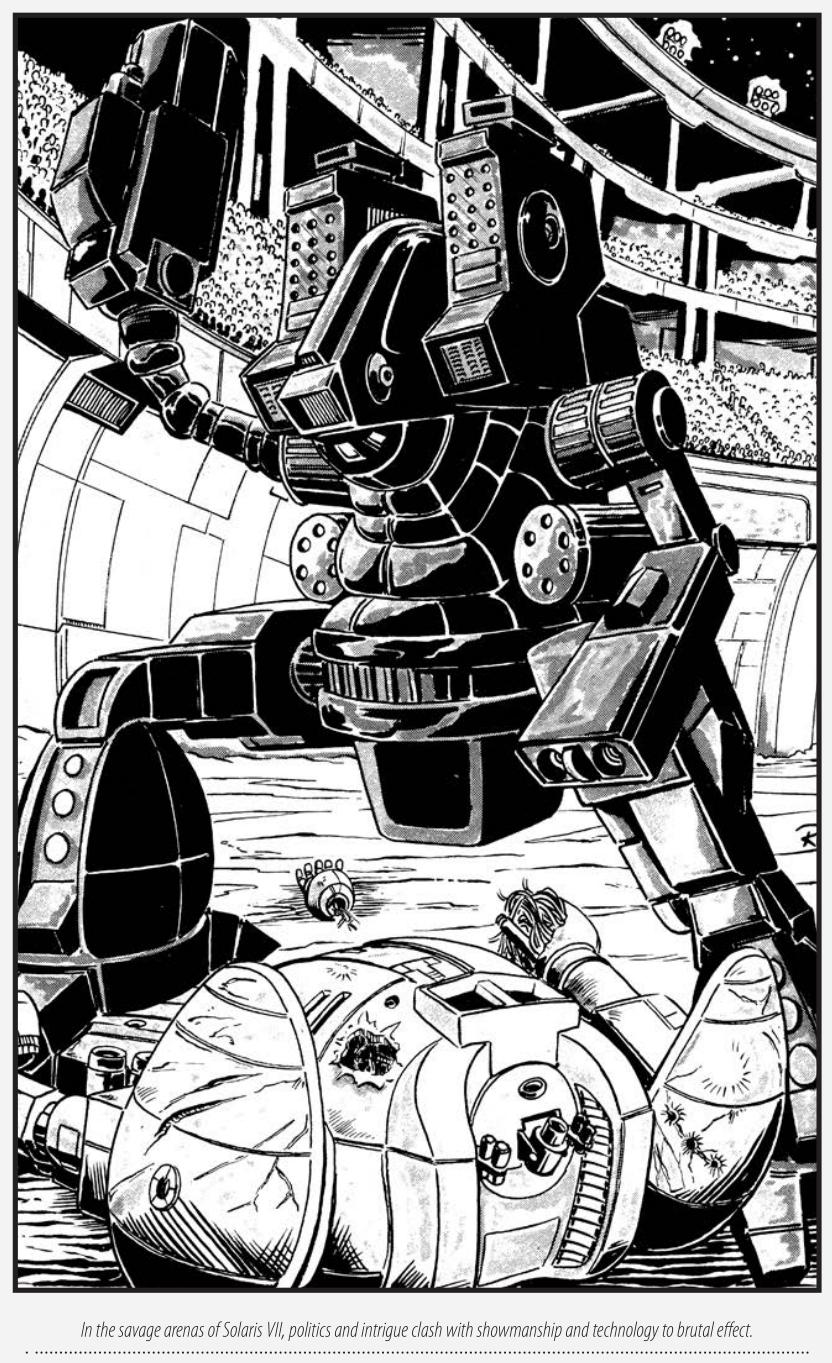
I love goofy robots.
Probably the most well-known place in all of BattleTech, Solaris VII is the location for 'Mech arena fights, making it a good place for players who want heavily-customized rides and gimmicky weapons like lances or wrecking balls.
Originally founded by the Free Worlds League (the inhabitants later switched sides to the Lyrans to avoid an invasion) thanks to its plentiful resources and its trade-friendly location, it soon became primarily about 'Mechs when various manufacturers used the vast amount of uninhabited land as testing ground for their newest models. This eventually led to competitions between the manufacturers, and the rest is history.
Not particularly amused about seeing one of mankinds finest technological marvels being used for entertainment and gambling purposes, the Word of Blake invaded Solaris VII to put an end to this fun.
Local resistance forces eventually managed to retake the planet three years later. Unfortunately, the fights caused severe damage to the capital city's infrastructure, and the alliance between rivaling stables and nationalities quickly fell apart after their victory. The newly-reformed planetary government now has to deal with various warlords messing around in the neighborhood.
The arenas are open yet again, but Solaris VII has certainly seen better days. Imagine if Las Vegas had a really bad year or two that turned it from a shining amusement mile into a bunch of slums with plenty of corruption and criminals.
Your Battletech Infodump of the Day: Alpha Strike
Not really setting-related stuff this time, but rather a wargame and good alternative to normal BattleTech if your players want to enjoy 'Mech combat with similar (even less!) complexity than human-scale combat and don't mind having to fudge things when they want interaction between the scales.
Alpha Strike is the shiny new rules system for hexless (though there are rules for playing with hexes) tabletop wargaming in the BattleTech world. Whereas normal BattleTech with its numerous hit locations and individual weapons (thankfully abstracted into weapon bays for spaceships) becomes quite cumbersome if you have more than a handful of units on each side, Alpha Strike can easily handle twice that amount or more, and unit stats now fit neatly on a check card.
Though the rules themselves aren't actually all that new, as they are heavily based on BattleForce, the BattleTech spinoff rules for handling larger engagements, with different variations depending on how far you want to "zoom out", up to playing out an entire planetary invasion on an abstracted map representing the planet's land mass. A proto-version of Alpha Strike also existing in rules suggestion to use BattleForce on a smaller scale.
Aside from streamlining many rules and condensing the various hit location into one value for Armor and Structural Integrity, both Alpha Strike and BattleForce get rid of individual weapons (with special abilities for stuff like Indirect Fire or different ammunitions) and just list how much damage the unit can deal at different standardized range bands. The assumption is that the unit will generall fire all its weapon at one target at a time, aka the eponymous Alpha Strike.
Or rather a unit would fire all of its weapons if it has enough cooling to support it. Weapons that would cause overheat are instead transferred into their own pool that the unit can use to cause extra damage at the cost of getting debuffed for a while.
A pretty nifty advantage over normal BattleTech is that almost every official unit has already been converted to Alpha Strike, and their unit cards are available for free. The supplement comes with conversion rules, but they are a bit time-consuming. But there's really nothing stopping you from eyeballing a unit's Alpha Strike stats, or even making generic units.
Sadly, I think they still haven't converted DropShips or WarShips, which is a shame as both Alpha Strike and BattleForce have the right amount of abstraction to handle these behemoths without going crazy.
Next Time: Phew, that didn't flow quite as steady as I hoped. Before tackling the supplement, I'd rather take on a little palette cleanser first, one that almost writes itself.
So, wanna see a far less pretentious version of what Monte might be cooking up? A game that combines OSR with FATE-like elements? Cause that's just what I will be covering.